THE SUSTAINABLE LUXURY ISSUE

APRIL 2023
N°5
A 55.55-CARAT
NECKLACE IN WHITE GOLD AND DIAMONDS, FEATURING
EMERALD-CUT DFL TYPE IIA DIAMOND.

CHANEL.COM

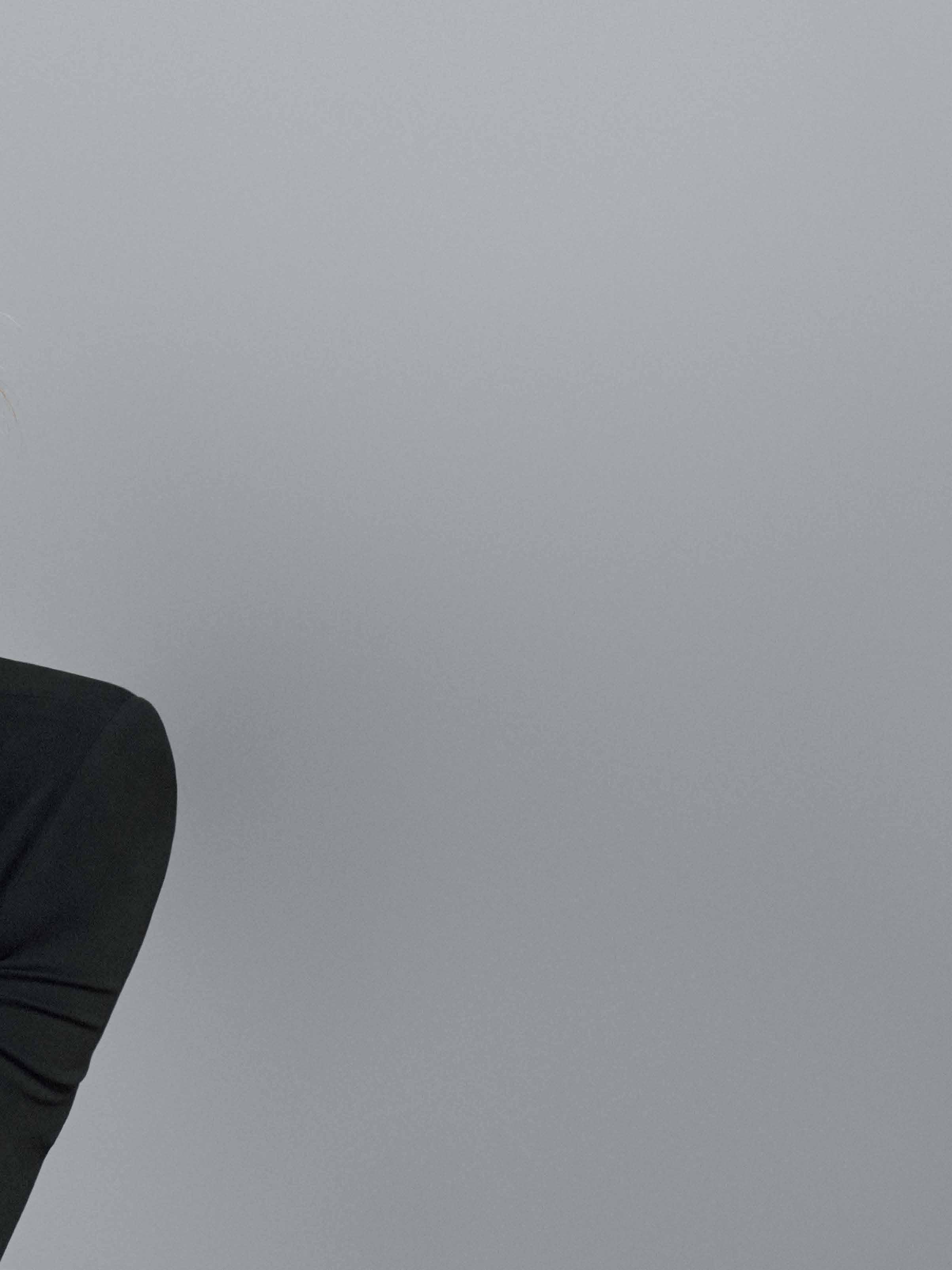













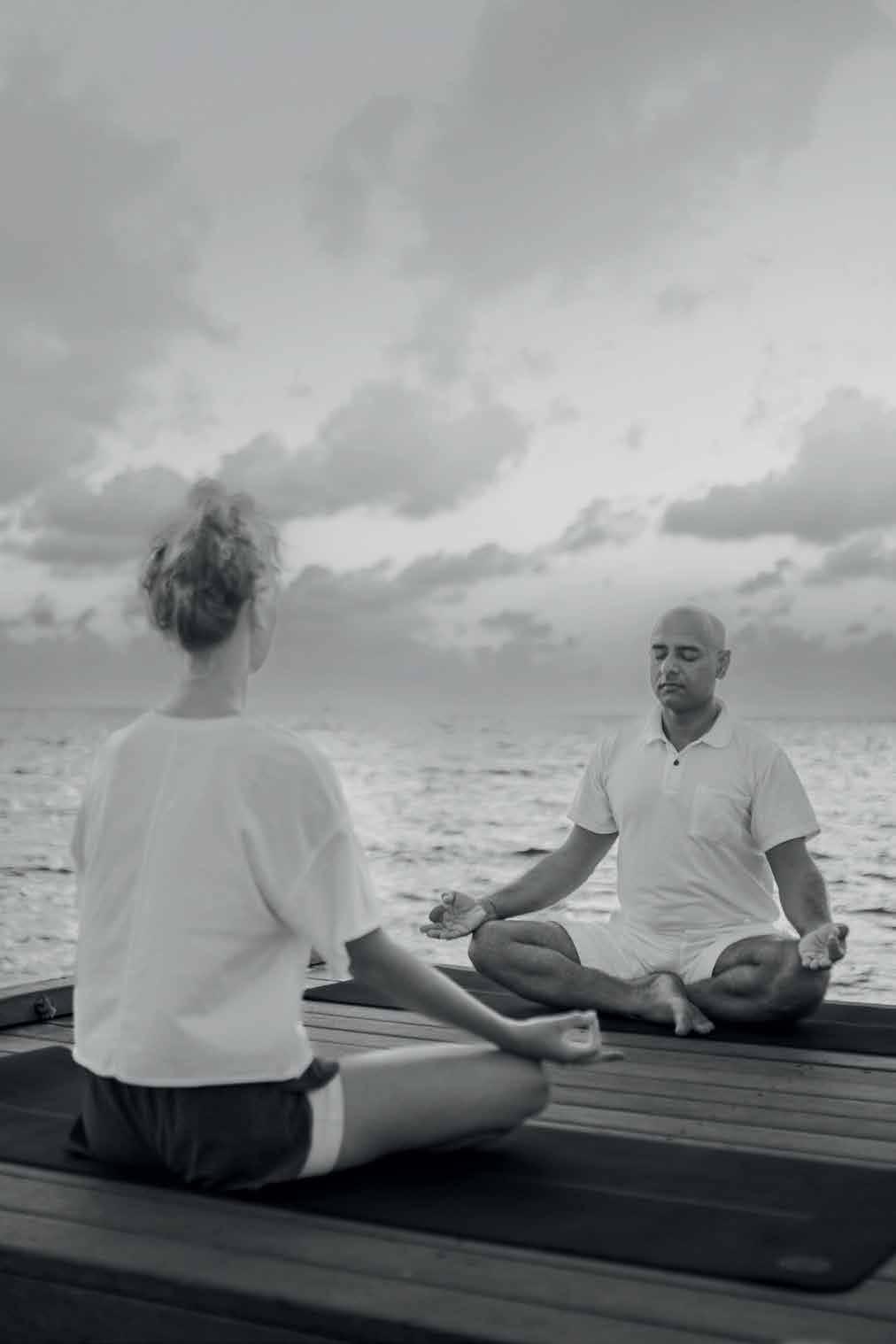
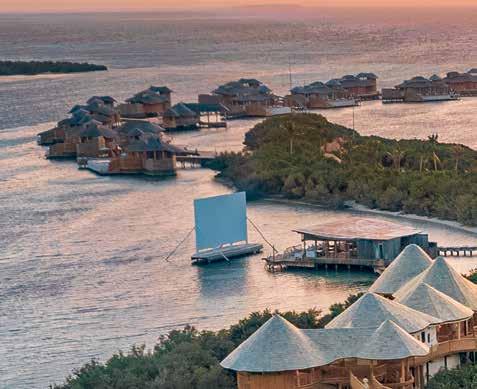














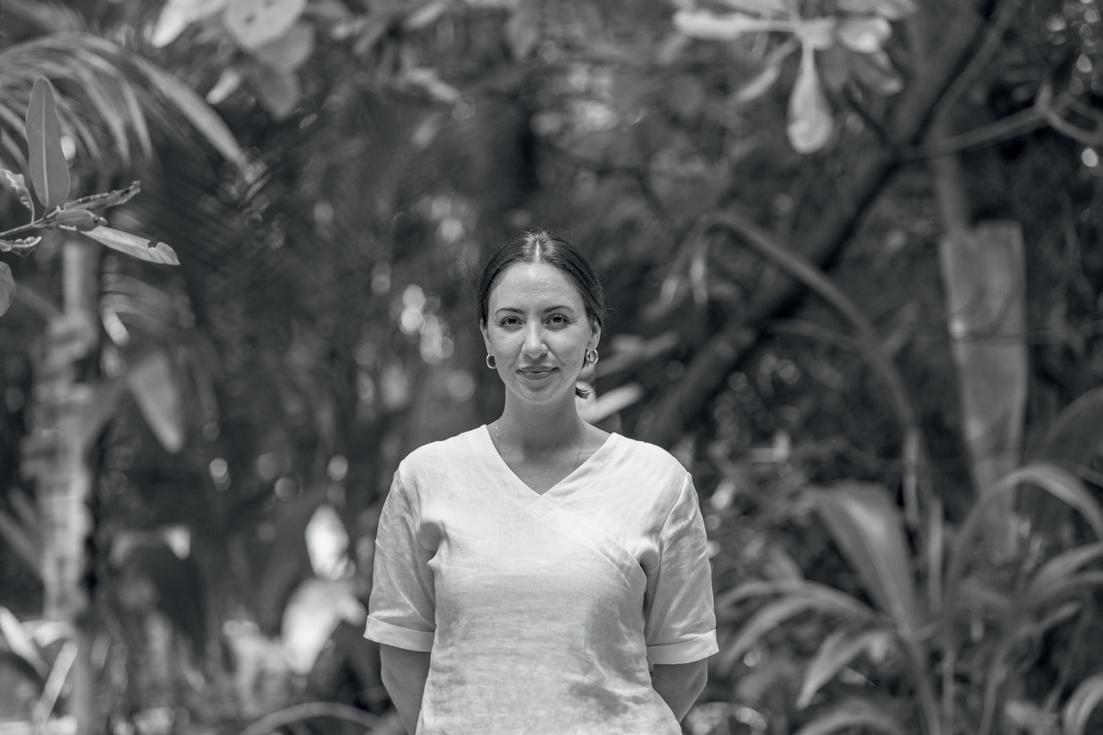



FEATURES
Thirty Two Time For Change
As the world’s first sustainable couturier, Ronald van der Kemp is pioneering change at the pinnacle of luxury fashion.

Forty Couture’s Renaissance
Why a new upcycling couture salon not only gives new life to barely worn clothes but to the people who repurpose them.
Forty Six Business Ethics
Stella McCartney has long pioneered the use of alternative materials in fashion. It’s serious business.
Contents APRIL 2023: ISSUE 139 9
Credit: Stella McCartney, Ramadan 2023
DISRUPTING DIAMONDS
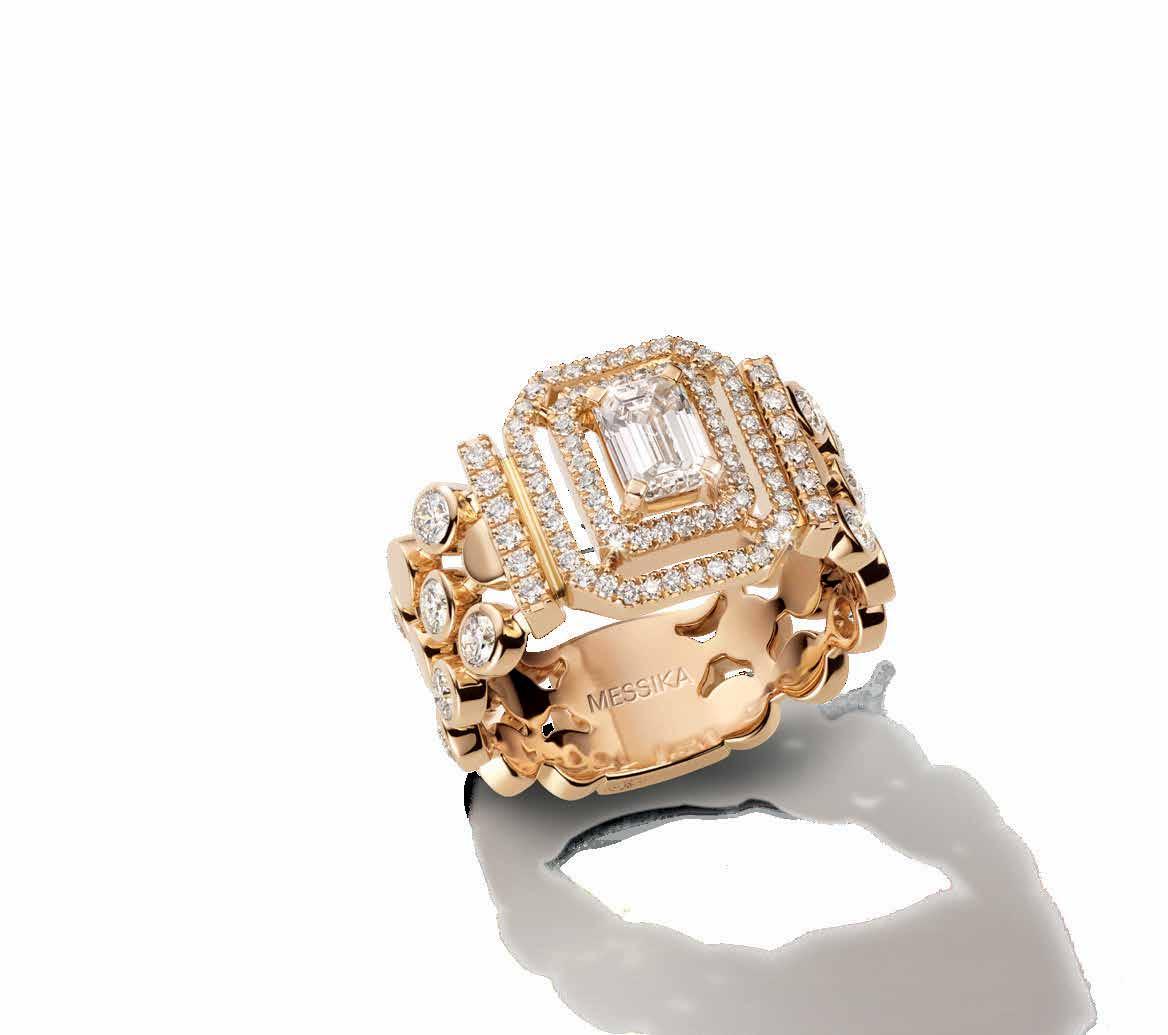
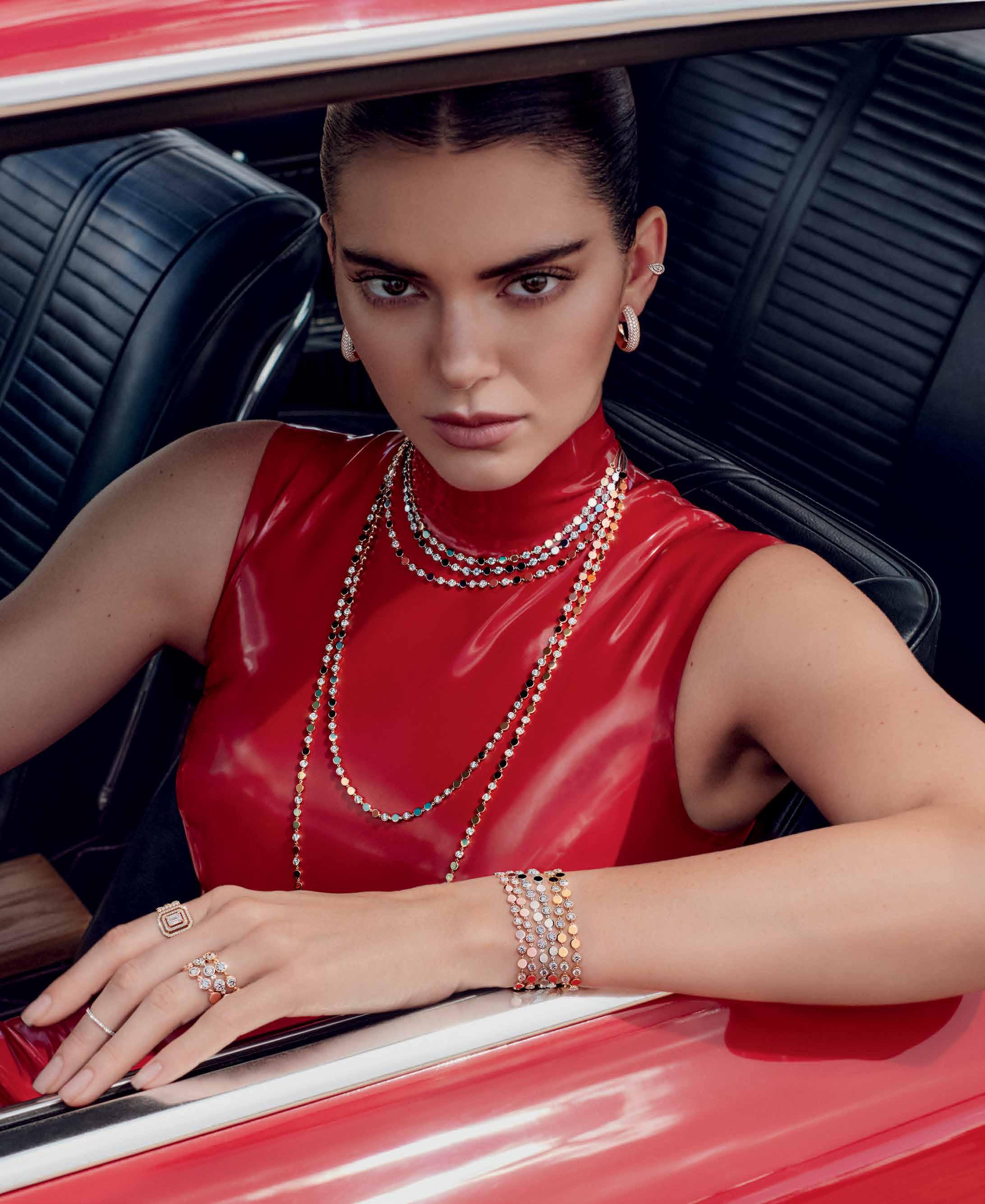
REGULARS
Fourteen Radar
Sixteen Objects of Desire
Eighteen Critique
Twenty Art & Design
Twenty Four Jewellery
Twenty Eight Timepieces
Fifty Four Gastronomy
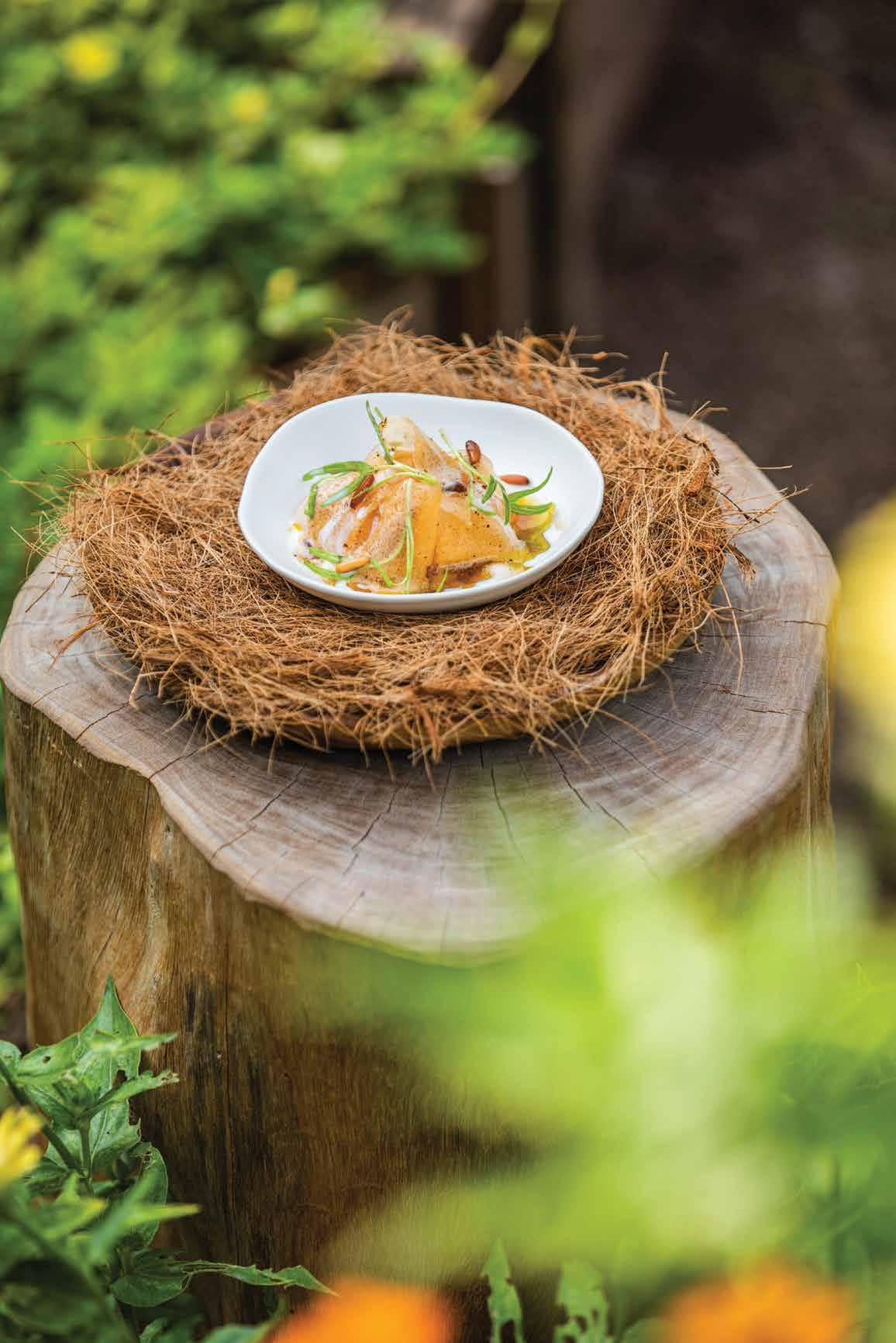
Sixty Two Travel
Sixty Four What I Know Now
Fifty Eight Gastronomy
Manu Buffara, Latin America’s finest female chef, on cooking to change the world.
EDITORIAL
Editor-in-Chief & Co-owner John Thatcher john@hotmedia.me
ART
Art Director Kerri Bennett
Illustration Leona Beth
COMMERCIAL
Managing Director & Co-owner Victoria Thatcher
PRODUCTION
Digital Media Manager Muthu Kumar
Media City, Dubai, UAE
Reproduction in whole or in part without written permission from HOT Media is strictly prohibited. HOT Media does not accept liability for any omissions or errors in AIR
11
Contents
APRIL 2023: ISSUE 139


Welcome Onboard
APRIL 2023
As a responsible corporate citizen, Jetex is committed to making a positive impact. Every action taken reflects our commitment to ethics, corporate social responsibility, and respect for the environment. They drive our performance and ensure the brand’s longevity. Achieving environmental and social responsibility requires both technical and strategic skills that are essential to steer operational transformation. Recently, travellers’ priorities have shifted to a greater social responsibility. While the aviation industry collectively contributes 2% of global CO2 emissions, executive aviation is just 0.04%. Jetex supports the International Air Transport Association’s (IATA’s) 2050 net-zero carbon emission goals and sees more private jet owners using sustainable aviation fuel (SAF), against a background of developing technologies, like hydrogen, and other emerging initiatives. Thanks to our success, we are able to further invest in causes we believe are right. It is a commitment that nourishes and sometimes exceeds the scope of our responsibility.
Luxury consumers are no longer willing to accept products and services that are simply a statement. Being iconic and exclusive no longer suffice for a luxury brand to survive, as buyers and travellers need better reasons to continue buying and travelling. Luxury is creating a vision of being as close as possible to nature. Nature, in its simple essence, is becoming the true expression of luxury.
Here’s to redefining luxury, and to contining to encourage brands to be responsible agents of change, to be a part of overcoming some of our global issues, and to play a key role in achieving some of the UN Sustainable Development Goals.
As always, thank you for choosing Jetex for your global private jet travels. All of us look forward to taking you higher in utmost comfort and luxury.
Adel Mardini Founder & Chief Executive Officer

Contact Details: jetex.com
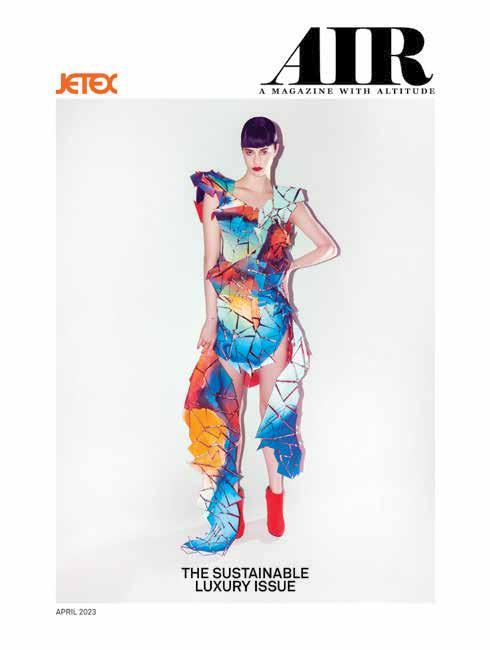
13 Jetex APRIL 2023: ISSUE 139
Cover : RVDK, Wardrobe 15, by Ferry van der Nat


Forging A Sustainable Path
Why sustainability is a driving force at Jetex
Sustainable development at Jetex is a strategic priority, closely aligned with the International Air Transport Association’s (IATA’s) 2050 aim to reduce the industry’s carbon emissions by 50%.
During 2022, Jetex has developed the world’s first pure green FBO and invested in the most cutting-edge technologies to drive efficiency. It has secured partnerships to support the development of sustainable aviation fuel and carbon capture, and is now looking forward to delivery of the first all-electric aircraft.
Jetex also supports the development of hydrogen as an alternative fuel source – the route to achieving zero emissions on short-haul routes by 2050. Fuelling at Jetex Le Bourget, Paris, is facilitated by a 100% electric refuelling truck, reducing the operation’s carbon footprint. Since February 2021, the company has worked with Shell to offer customers a carbon offsetting option.
At the same time, Jetex’s sustainability policy drives competitiveness, as it sharpens the company’s business processes and makes the brand more competitive – delivering the best value to its customers globally while maintaining the levels of supreme luxury and service that epitomise the Jetex brand.
As a responsible member of the executive aviation industry, Jetex has made its own inroads into lowering CO2 emissions:
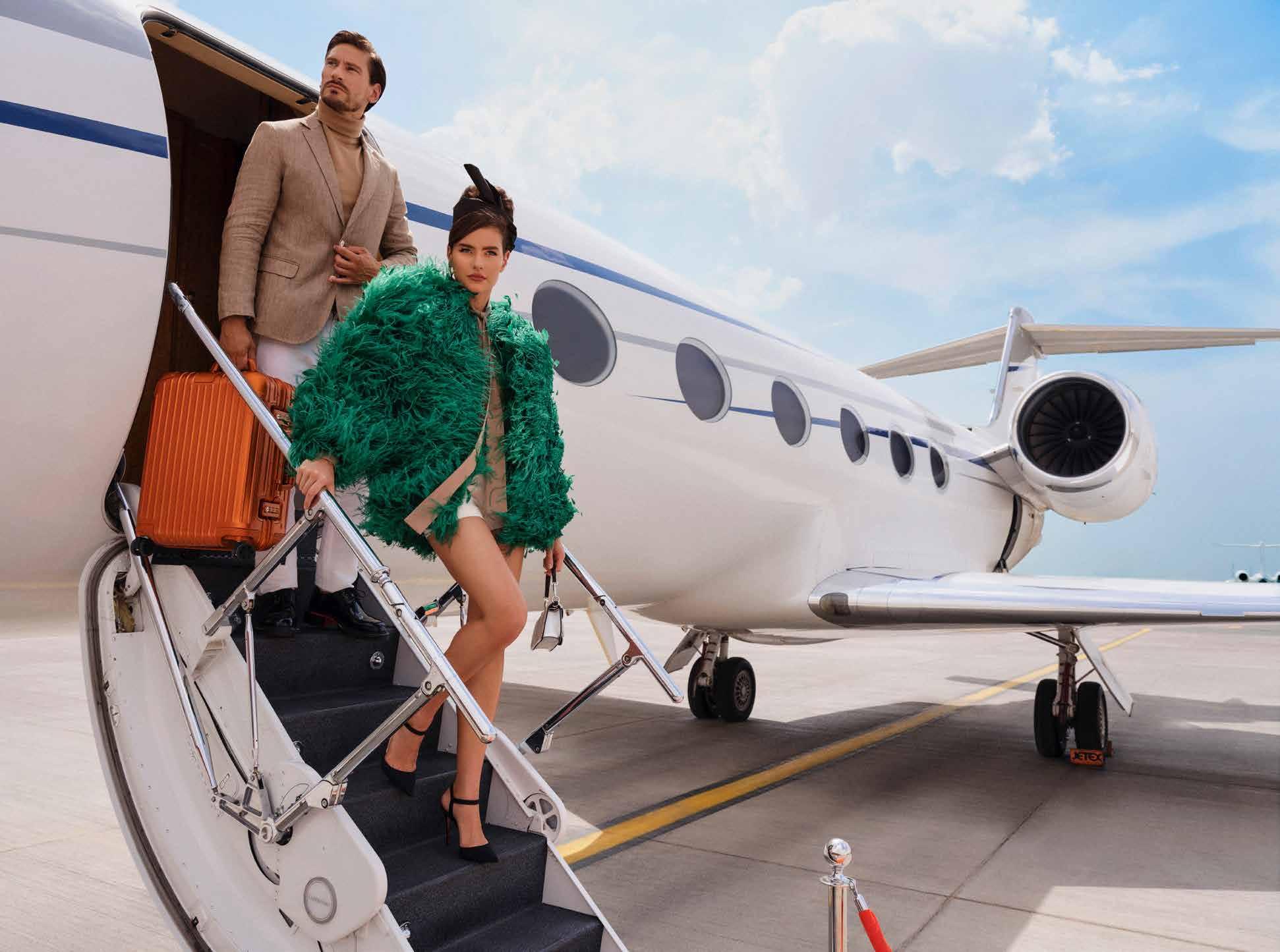
February 2021: Jetex started offering guests a tree-planting initiative as a way of offsetting the carbon impact of their luxury travels.
August 2021: Jetex started offering guests the option to use SAF.
September: 2021 Jetex showed its commitment to the IATA’s ambitious
emissions reduction goals by offering SAF at Helsinki Airport.
November 2021: Jetex signed a memorandum of understanding (MOU) with Eve Urban Mobility to develop a safe, accessible and green eVTOL Urban Air Mobility (UAM) system.
January 2022: Jetex & Berlin Neuhardenberg Airport announced the world’s first pure green FBO development in the German capital.
May 2022: Jetex developed a strategic partnership with Volocopter GmbH to defining a safe and sustainable UAM model of urban air mobility (UAM) through an eVTOL suite of services. 2022-2023: Jetex is in the process of installing electric-driven equipment for airside operations.
2023 and beyond: Jetex will continue to stay up to date with emerging innovations and ways it can contribute to a more sustainable aviation industry.
Jetex APRIL 2023: ISSUE 139
16

magical home cinema experience Beovision Harmony & Beolab 90 BANG & OLUFSEN DUBAI MALL SHOWROOM. FIRST LEVEL. FASHION AVENUE. +971 4 339 9314
A
After its staging last year in the extraordinary landscape of Saudi Arabia’s AlUla, Desert X 2023 has popped-up once again in California’s Coachella Valley. Continuing to build on the social and environmental themes explored in earlier editions, this year’s version, which shows until May 7, sees artists from Europe, North America and South Asia enliven the sparse environment through 12 installations. Among them is No.1225 Chainlink , by BritishBangladeshi artist Rana Begum, a colourful piece that seeks to diffuse the common role of the chainlink fence as a divider by arranging it in way that easily allows light and air, sand and water, as well as people, to filter through it.

18 AIR Radar APRIL 2023: ISSUE 139
Credit: Desert X 2023 installation view, Rana Begum, No.1225 Chainlink, photo by Lance Gerber, courtesy the artist and Desert X

19
OBJECTS OF DESIRE
Master craftsmanship, effortless style and timeless appeal; this month’s must-haves and collectibles
OBJECTS OF DESIRE
LOVE BRAND & CO SPRING-SUMMER 2023
The husband and wife team behind Love Brand & Co founded their Bahamasinspired company with a long-held commitment to only commercialise their love of travel and exploration if it could also help protect the world. They succeeded, recently acquiring B Corp certification,
a body that recognises a brand’s business ethics, conservation work, and sustainable values. The products themselves are made from organic, recycled or plant-based fabrics, with the SS23 collection — the likes of swimming trunks, linen and hemp shirts — styled around the idea of paradise.

1
OBJECTS OF DESIRE
THAELY BLOOD RED
The story goes that Thaely was initially developed as a design exercise by company founder Ashay Bhave, who wished to find a solution to the environmental issue caused by the billions of plastic bags used and discarded each year. From this plastic waste Ashay
developed a fabric, which became the basis for a single sneaker prototype, based on early noughties basketball shoes. Now there’s a whole collection of them (available from THAT Concept Store) with each style fashioned from recycled bottles and recycled rubber soles.

OBJECTS OF DESIRE 2
CDLP SWIMWEAR
Swedish brand CDLP was set up in 2016 with an intention to revolutionise men’s underwear by using future-orientated materials. It’s fair to say they succeeded — made from Lyocell, a product derived from renewable wood sources, you simply won’t wear anything as comfortable. From there
the brand’s offering was expanded to include the likes of T-shirts, sweatshirts, and lounging outfits for both at home and beside the pool. Its swimwear range is created from Econyl®, an Italian-sourced premium nylon fibre regenerated from ocean and landfill waste.

3 OBJECTS OF DESIRE
PRADA ETERNAL GOLD
100% certified recycled gold is the focus of Eternal Gold, Prada’s fine jewellery collection which has been crafted to pass down through the generations. The brand’s triangle motif is the ever-present element across snake bracelets, heart motifs, chain necklaces, ribbon chokers,
earrings, and pendants, with a sprinkling of diamonds that, like the gold, has been traced right the way through the production cycle of mining, cutting, setting, and polishing, a process logged on the Aura Blockchain Consortium for customers to access.

4 OBJECTS OF DESIRE
OMNĒQUE JANESICH ART DECO EMERALD AND DIAMOND PLAQUE RING
Launched as an online marketplace that enables pre-owned, still-loved jewellery to be passed on to the next owner — or to be remodelled to better suit the current owner — Omnēque’s unique pieces are authenticated by top industry experts. The Italian jewellery
house of Janesich was established in 1835, later finding fame for producing some of the most stylish pieces of the Art Deco period. Indicative of their craft is this beautiful diamond plaque ring, at the heart of which is a stunning emerald.

5 OBJECTS OF DESIRE
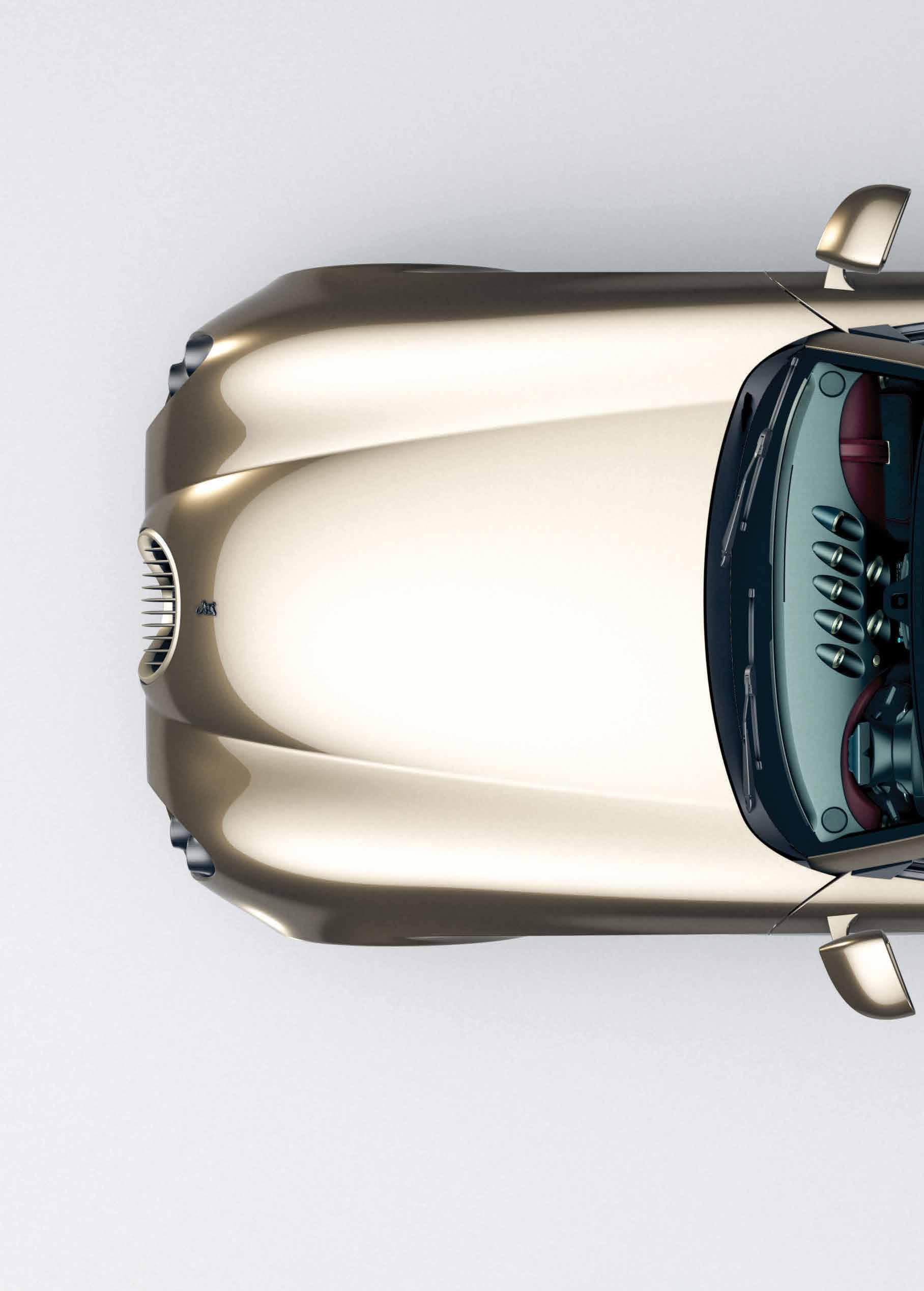

OBJECTS OF DESIRE 6
WIESMANN PROJECT THUNDERBALL CONCEPT TWO
With the entire first year production run of their all-electric, two-seater convertible Project Thunderball sportscar already sold out ahead of their 2024 delivery dates, Wiesmann has whet the appetite for future models with the release of three concept cars inspired
by the original Project Thunderball. The Roaring Twenties, and in particular the fictional F. Scott Fitzgerald character, Jay Gatsby, is the inspiration for this bold, gold-hued model, which pairs its opulent exterior with a deep burgundy leather interior and soft-touch velvet details.
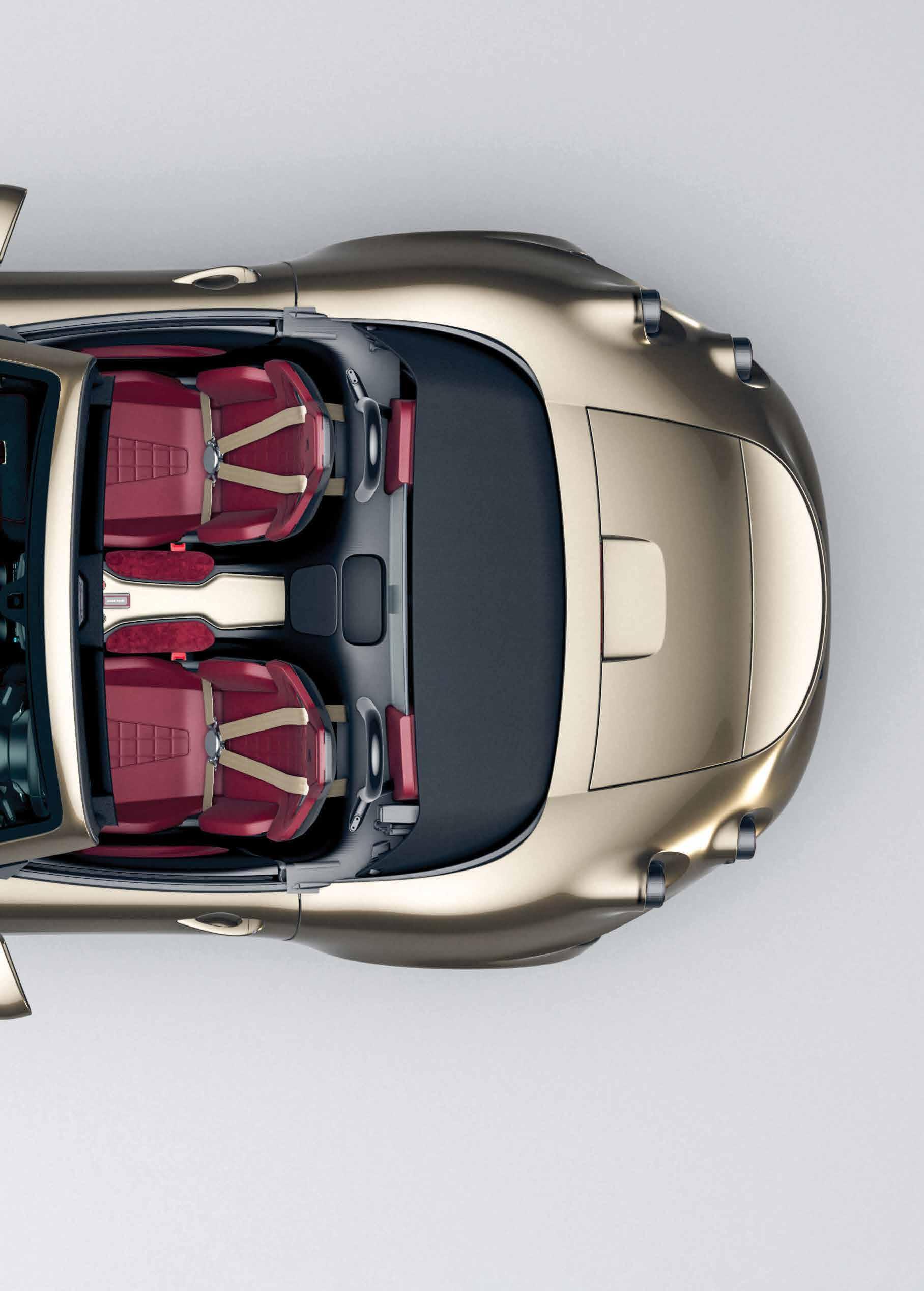
7 OBJECTS OF DESIRE

8 OBJECTS OF DESIRE
HÄSTENS 2000T ®
OBJECTS OF DESIRE
Film
Hilma
Dir. Lasse Hallström
A biopic of Swedish artist and feminist pioneer Hilma Af Klint, who painted the world’s first abstract works.

AT BEST: ‘An intriguing, confounding subject, Af Klint is full of contradictions.’ — Wendy Ide, Observer
AT WORST: ‘You’re much better off seeking out the next showing of Klint’s art near you.’ — Lee Jutton, Film Inquiry
Chevalier
Dir. Stephen Williams
A drama inspired by the true story of celebrated composer Joseph Bologne, Chevalier de Saint-Georges, the illegitimate son of an African slave and a French plantation owner.
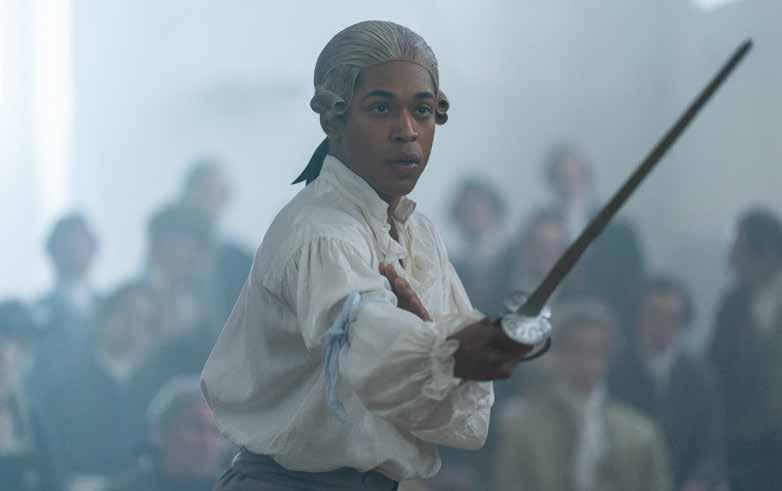
AT BEST: ‘The thoughtfulness of the script, the direction, and the gorgeous cast make this a movie worth the watch.’ — Stacey Yvonne, Black Girl Nerds
AT WORST: ‘Takes a grand subject and dumbs it down into a strident, shallow melodrama pitched at the rear balcony.’ — Ty Burr, Ty Burr’s Watch List
Somewhere In Queens
Dir. Ray Romano
The blue-collar tradition of a New York family faces upheaval when their son’s chance at a life-changing basketball scholarship is jeopardised.
AT BEST: ‘Has the heart, the humour, and the deeply set focus on family to make it an undeniable success.’ — Stephanie Archer, Film Inquiry
AT WORST: ‘The psychology here may not be particularly complex, but it’s handled with a soft touch that keeps its story humming along at a natural volume.’ — David Ehrlich, IndieWire

How To Blow Up A Pipeline
Dir. Daniel Goldhaber
Adapted from the controversial ideas in a book by Andreas Malm, a group of young environmental activists attempt a daring mission to sabotage an oil pipeline.

AT BEST: ‘A pacey, good-looking, and technically adroit thriller with effective suspense sequences.’ — Will Sloan, Cinema Scope
AT WORST: ‘Won’t change the world, but it’s a romantic and hardly outrageous consideration of what it might mean to really try.’ — Mark Asch, Little White Lies
22 AIR Critique
APRIL 2023 : ISSUE 139
Written as an homage to the timeless classic, Little Women, Ann Napolitano’s Hello Beautiful asks whether a catastrophic family rift that changes the lives of all involved can be healed by once rooted loyalty. “Another tender tearjerker… Napolitano chronicles life’s highs and lows with aching precision. Hello Beautiful will make you weep buckets because you come to care so deeply about the characters and their fates. [Napolitano] compels us to contemplate the complex tapestry of family love that can, despite grief and loss, still knit us together. She helps us see ourselves — and each other —whole,” writes The Washington Post Said The New York Times Book Review : “Radiant and brilliantly crafted. Napolitano’s work… resists the easy satisfactions of the sentimental and never settles for simple answers to emotional predicaments faced by her characters.”
Oprah Quarterly was also effusive in its praise. “This sumptuous family saga is one of those rare novels whose singular characters are so beautifully rendered, it’s as if they’re
your best friends, and you’re grateful to be in their orbit. Napolitano’s homage to Little Women, albeit set in late-20th century Chicago, will prompt you to slow down as you read, never wanting the book to end. When it does, prepare for tears.”

As its author, Hollywood funnyman Seth Rogan, describes, Yearbook is “a collection of true stories that I desperately hope are just funny at worst, and life-changingly amazing at best. (I understand that it’s likely the former, which is a fancy ‘book’ way of saying ‘the first one.’)”

Despite that belief, the reviews have tended to favour the latter (aka the second one). “The actor and writer will have you keeled over in laughter with his memoir, made up of a collection of essays that will make you think about the world differently… Fasten your seatbelts for this pageturner, folks,” says Men’s Journal. “In need of oddball anecdotes and lots of F bombs? Seth Rogen has you covered… Yearbook features a hilarious collection of real-life stories and personal essays that delve into
his adolescence and career,” writes USA Today, while Rogan’s own mum states: “Overall, I think it’s more sweet and funny than anything, so I like it, and I’m glad he wrote it, but I’d be even more glad if he called me more.”
True Biz by Sara Novic chronicles a year of seismic romantic, political, and familial shifts for a teacher and her students at a boarding school for the deaf. “Goodness, I can’t even begin to put into words all the feelings this book provoked!”, says actress Reese Witherspoon, reviewing for her own book club. “An eye-opening and heartfelt story about human connection and the beauty and adversity woven into the deaf community and culture. It is both an educational and electrifying peek into a family’s life as they fight to forge connections even as the outside world threatens to close the door on them. I loved this story so much. It is not one to miss.”
Publishers Weekly hails it simply as “Brilliant”, while Booklist writes that it’s both “Moving and revelatory.”

23 Critique Books APRIL 2023 : ISSUE 139
Rage Against The Machine
How the work of Indonesian artist Maryanto shines a light on a land transformed into darkness
WORDS: JOHN THATCHER
The success of Art Dubai, which staged its sixteenth edition last month, can be attributed in part to its inherent policy of championing artists who are broadly underrepresented in the wider art world. Often these artists showcase skills, practices and traditions that are dying out, lost to technology’s rapid advancement across the globe. In some cases, they’ll use these skills to highlight whole communities that are suffering the same fate, where the blame lies not with technology but with humankind.
Impassioned Indonesian artist Maryanto, who utilises a scratching technique similar to etching to bring his canvases to life, used his display space at Art Dubai to highlight an environmental and social issue dear to his heart and homeland. “My primary concern revolves around individuals in South Kalimantan who have lost their land and forests,” he explains.
“In the past, they used to live as a tribe and rely on the land to provide for their basic needs. The forest, which was once a source of food, shelter, and medicine for the community, is now almost entirely destroyed due to the expansion of the palm oil industry and coal mining in the region. Despite the efforts of the locals to protect the remaining forests, the palm oil industry’s rampant development persists, leaving the people to continue their fight and struggle as the
encroachment of its forests continues.”
It’s a process that started in the 1970s, when the ruling government introduced a programme of transmigration, which brought in people from the island of Java to cultivate palm trees in South Kalimantan, clearing the land for industry. “The indigenous tribes in the area were initially taken aback by the government’s decision, as they believed that the forests were collectively owned by all members of the tribe, rather than individuals,” outlines Maryanto.
“But any opposition to palm oil production was met with punishment, including imprisonment or military action. As a result, the tribes reluctantly complied with the government’s demands. They were left with no choice but to follow the rules, which also required them to plant palm trees.”
Indonesia is the largest exporter of palm oil, accounting for 68% of the world’s production. But its damaging impact on South Kalimantan is marked. “During my first visit to the area, I was taken aback by the stark contrast between my expectations and reality,” recalls Maryanto. “I had always imagined Kalimantan to be a lush rainforest teeming with wildlife, where local communities lived in harmony with nature. However, what I found was an area heavily industrialised, where the environment has been irreversibly damaged.
APRIL 2023: ISSUE 139 Art & Design AIR 24

25
“I spoke to local people who felt helpless in the face of the exploitation and destruction of their ancestral lands. They recognised that their land was being destroyed and they were being deprived of their livelihoods, but they lacked the resources and influence to make any meaningful change. They were powerless to stop the destruction.”
Maryanto reveals the tensions that lie within these lands through a tedious method of layering and scratching. “I start with a linen canvas and apply white gesso, before covering the entire canvas with black acrylic paint. I then scratch away lines on the black surface to reach the white underlayer and reveal my paintings.”
His monochrome paintings depict both the brutal industrialisation of lush forests and lost traditions. 2023’s Palm Spirt concerns a ceremony performed for the purpose of healing the village, honouring ancestors, and seeking blessings for the environment. Lasting from one to six days, it involves collecting 100 types of plants, leaves, and roots from the forests as offerings, which is becoming increasingly difficult to assemble as forests are cleared.
“I find black and white to be a powerful and direct medium that captures the essence of my artistic vision,” outlines Maryanto. “My inspiration comes from the Indonesian Mooi Indie paintings popularised during the Dutch colonial era, which depicted Indonesia as a tropical paradise, full of exotic beauty. However, my work seeks to contradict these once idyllic spaces that have been corrupted by systems of power and instead depicts the harsh reality of the exploited landscape and the destructive capitalist scene that has resulted in a dystopia.
“Unfortunately, many aspects of the situation are difficult to reverse. The community is struggling to protect the last remaining forest they have, which is located in the mountains and is not easily accessible for the development of a palm plantation. However, even the locals have become individualistic and egoistic, resulting in illegal logging that threatens the forest. Although there is always hope for change, it will be a challenging task. The community has become dependent on the capitalist system, making it difficult to revert to their traditional ways of life.”
Though it portrays the bleak reality, scratched into Maryanto’s powerful work is his hopeful message. “I wish to convey the idea that we can avoid being driven by greed. It is important to realise that our consumption habits have a significant impact on places and people from where these products are sourced. Often, we are unaware of the origins of the products we use and the processes involved in their production. It is crucial for people
to be knowledgeable about the origin of their consumer goods and to be mindful of their impact on the environment and local communities. Palm oil is found in numerous products, such as soap, chips, bread, and cosmetics, and it is imperative for people to understand the consequences of supporting this industry. I urge people to respect the origins of the products they consume and take an interest in the impact of this massive industry.”
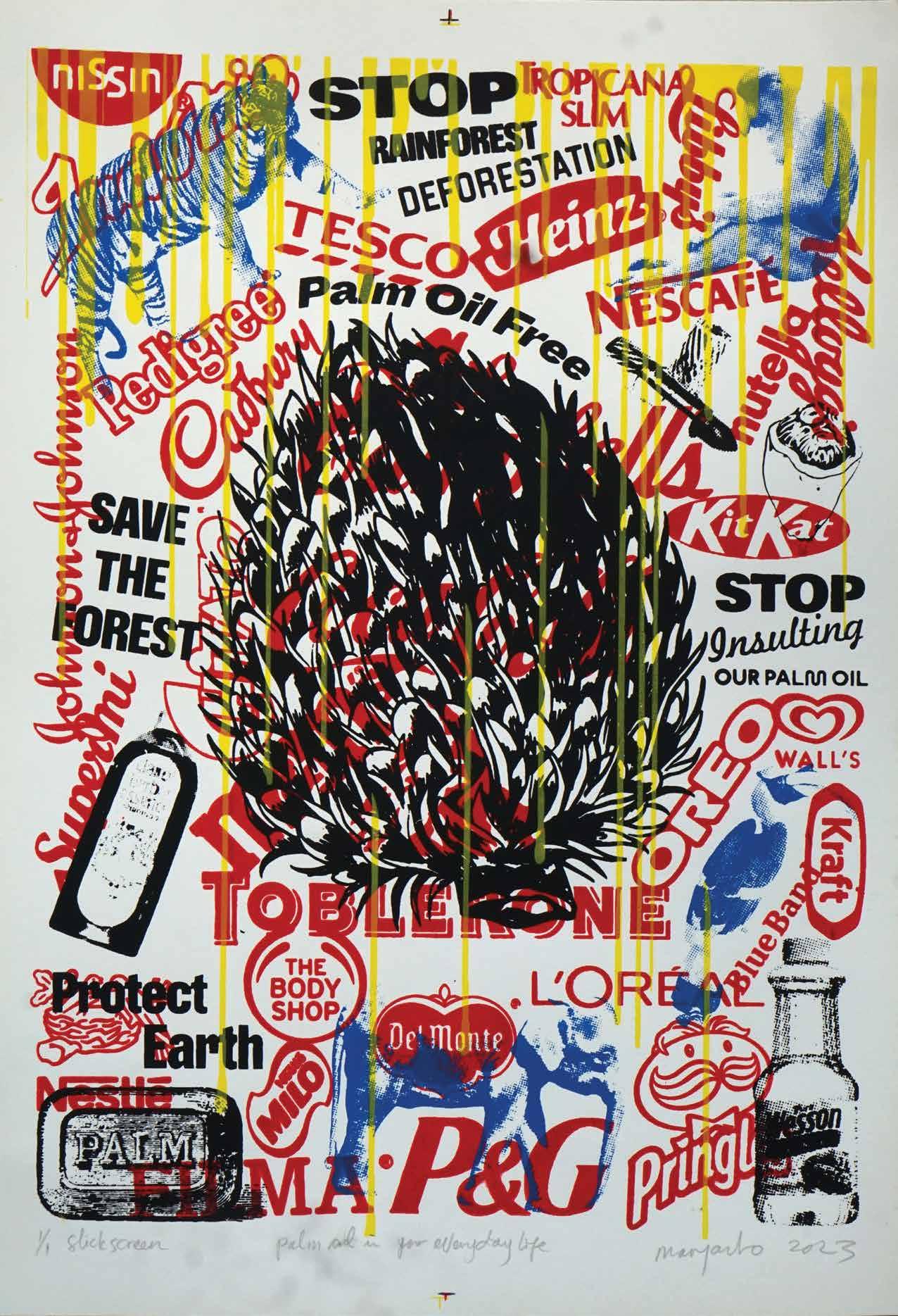
AIR 26
‘ It is crucial for people to be knowledgeable about the origin of their consumer goods and to be mindful of their impact on the environment and local communities ’
Opening pages: Palm Spirit, 2023

Opposite page: Palm Oil In Daily Life, 2023
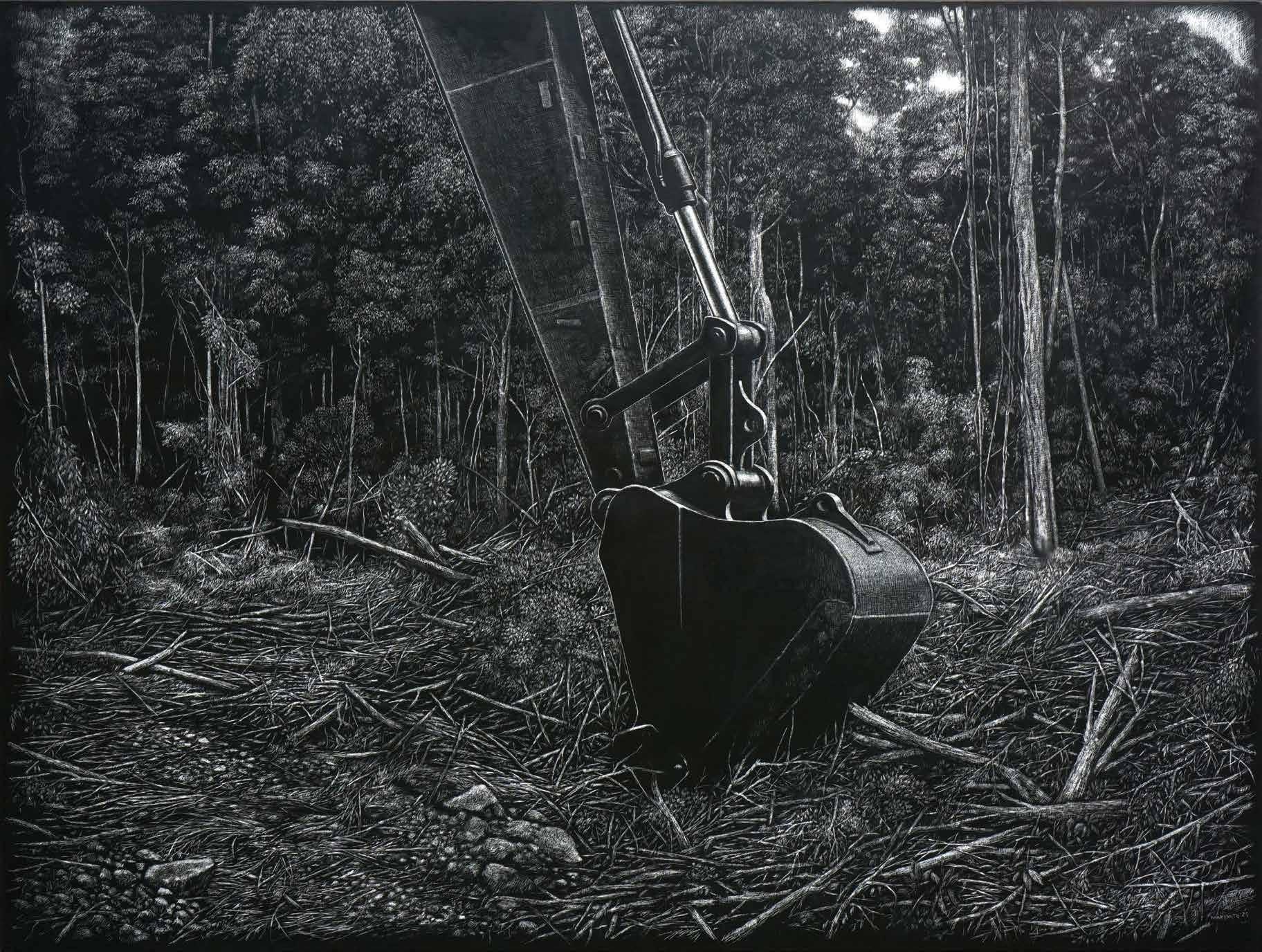
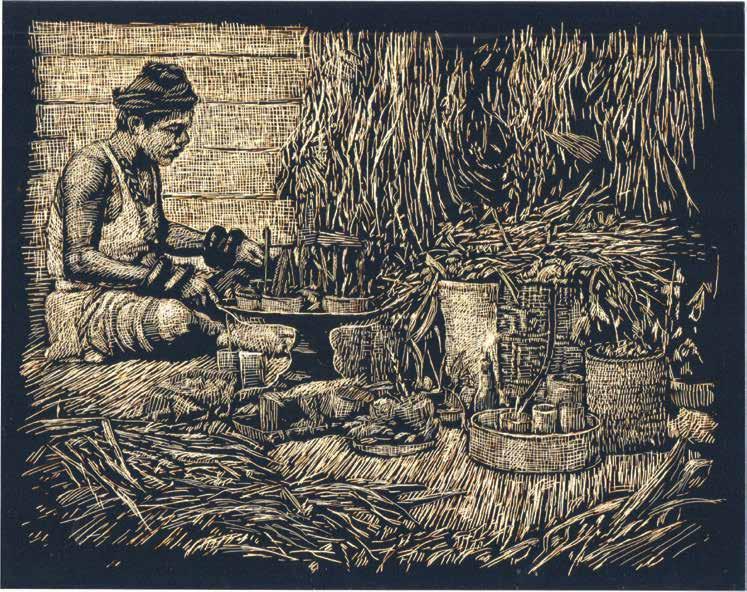
This page, clockwise from left: Coal Port, 2023; When Trees Fall, 2023; Fresh Fruit Bunch, 2023; ‘Mulung’ In Belian Ritual, 2023

27
Game Changer
Richard Mille’s RM 07-04 Automatic Sport is another example of a watchmaker that always delivers a peak performance

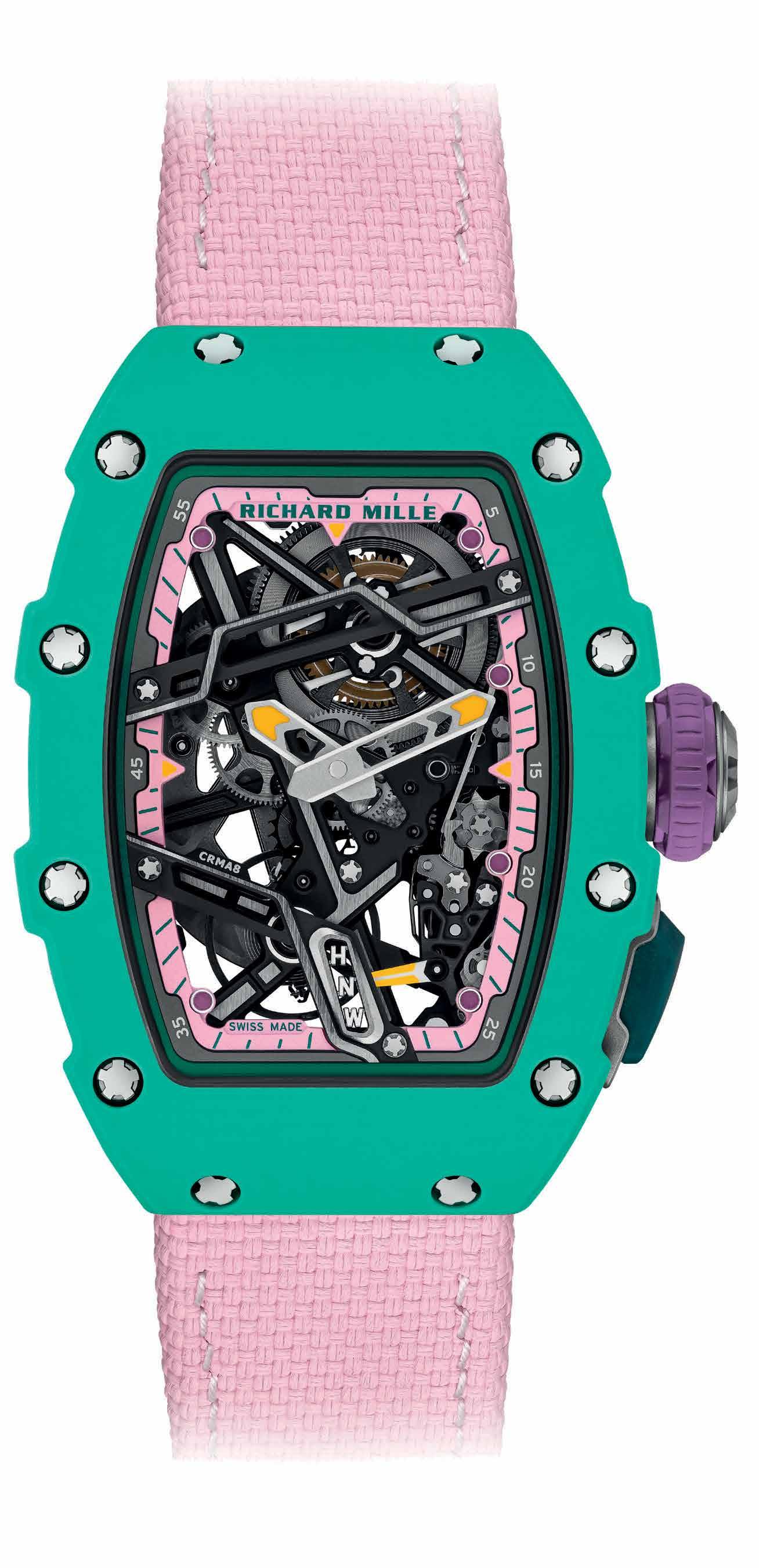
The release of the RM 07-04 is a timely reminder of how Richard Mille’s appreciation of sport runs deep, indulging a broad and often personal passion for its myriad forms — from motor racing and tennis through to free diving and golf — but also highlighting an innate understanding of what it takes to reach the pinnacle of performance. To achieve the impossible.
It’s an understanding and drive for perfection that’s manifest in a range of Richard Mille sports watches which shatter all pre-conceived ideas of what a sports watch should and can do — let alone what it should look like — each painstakingly produced to meet the unique demands of individual athletes and the sports in which they excel. Take, for example, the RM 027 Tourbillon, the first in a series of watches precision engineered for arguably the world’s greatest ever tennis player, Rafa Nadal, to wear during matches and therefore able to meet the rigorous demands of championship-level competition, including the shock that reverberates through the wrist from a scorching forehand stroke, which, in Nadal’s case, routinely tops 120km/h. After years of development and testing, Richard Mille’s solution was at the time the world’s lightest watch, a remarkable feat given its critical need for durability.
The Masters-winning golfer Bubba Watson can generate speeds of up to 312 km/h with his swing, the complex dynamics of which — including the impact from striking the ball — were picked apart by Richard Mille’s engineers and the solutions reassembled in a series of highly complex tourbillons for the American to wear on tour. Similarly, Olympic skiing star Alexis Pinturault required a timepiece with the ability to excel in both extreme temperatures and at high altitude, while being lightweight and durable to the ergonomic demands of slaloming down slopes.



What’s evident is that the bigger the challenge a sport’s physical and mechanical constraints provides, the higher Richard Mille rises to meet it.

Now, all that Richard Mille has learnt from operating at the cutting edge of ultra-high level watchmaking and elite athletic performance, pushing boundaries, shattering convention, has been applied to the new RM 07-04 Automatic Sport, the brand’s first women’s sports watch.

Richard Mille has long championed women in sport, launching motorsport’s first ever all-female racing team in 2020, and for this debut timepiece the brand shines a spotlight on six inspiring sportswomen: racing drivers

Aurora Straus and Margot Laffite; golfer Nelly Korda; track and field stars Nafi Thiam and Yuliya Levchenko; and three time Olympic gold medalwinning snowboarder Ester Ledecká.

Various sports, multiple requirements, one watch to suit all — such are the challenges when you work at Richard Mille. “Nafi Thiam, Ester Ledecká and Yuliya Levchenko, needed a lighter piece, whereas Nelly Korda, Aurora Straus and Margot Laffite were looking for a more versatile watch,” revealed Amanda Mille, Brand and Partnerships Director. Upping the ante, Richard Mille’s technical team made the design challenge threefold: “Extreme skeletonisation, integration of the case




with the movement, and inclusion of an inverted function selector,” outlined Salvador Arbona, the brand’s Technical Director For Movements.

The resulting, remarkable timepiece –which utilises materials such as Quartz TPT® and Carbon TPT® for the case, and weighs in at just 36 grams, strap included, while still able to guarantee shock resistance at 5000g’s – took a full three years to develop and comes in six colour-coded styles. Black for the Carbon TPT® model, and creamy white, mauve, salmon, green and dark blue for the five Quartz TPT® models.
“Offering a women’s skeleton sports watch is a gamble that few have dared to take,” said Cécile Guenat, Richard Mille’s Creative and Development Director. But then there is no watchmaker quite as daring as Richard Mille. A brand that competes only with itself at the summit of the watch game.


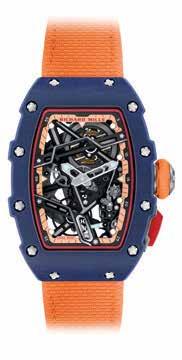

AIR 31
Clockwise, from top left: Yuliya Levchenko; Nelly Korda; Ester Ledecká; Nafi Thiam; Margot Laffite; Aurora Straus
Taking Responsibility
The jewellery industry is keen to clean up its act, with a whole wave of young brands going about it in uniquely brilliant directions

Jewellery APRIL 2023: ISSUE 139 28 AIR
WORDS: JOHN THATCHER

29
Anyone who has tried to substitute sustainable practices into their daily routine will vouch for the fact that it’s far from a walk in the park. Change takes time, especially so if your way of doing things is ingrained. For the biggest jewellery brands — their supply, production, and distribution chains multi-layered — the process of change is particularly protracted. That’s why when it comes to sustainability they talk long-term of meeting targets, reaching goals, and, in the case of Chopard, embarking on a journey.
Their journey started a decade ago, the mission: “to change not only Chopard as a company and brand, but also the entire industry,” said Caroline Scheufele, the brand’s CoPresident and Artistic Director.

The first step saw Chopard engage with The Alliance for Responsible Mining to support and enable gold mining communities to achieve Fairminded Certification (the guarantee of being part of a responsible and conflict-free supply chain). Responsible watch and jewellery lines followed, most notably the spectacular Green Carpet Collection — unveiled on the red carpet in Cannes in 2013 — to which Scheufele continues to add unique pieces. But a genuine milestone was reached in 2018 when it was announced that family-run Chopard would commit to using only 100% ethical gold in its watch and jewellery pieces — the first of such brands to do so.
“The biggest challenge was change itself, because people are used to doing things in a certain way,” said Scheufele. “The people in our workshops had a routine and it was hard for them to go out of their comfort zone. We had to make them understand why we were doing this, because it’s they who have to do the job. It was a challenge indeed, but we obviously proved we could do it.” Ethical practice has long been a key consideration at Tiffany & Co. At the turn of the century, it was among the first companies to stop using coral in jewellery, and has since established an overarching policy of responsible practice as it takes important steps towards hitting its 2025 Sustainability Goals. One giant leap came in 2020, when it announced an industry first in diamond traceability — namely, the ability to state the country of origin for
each stone over 0.18 carats. By 2025, 100% of the individually registered diamonds and precious metals used by Tiffany in its jewellery production will be traceable. “We believe that our customers deserve to know that a Tiffany diamond was sourced with the highest standards, not only as regards quality, but also social and environmental responsibility. Diamond traceability is the best means to ensure both,” believes Victoria Reynolds, the brand’s Chief Gemologist. While such legacy brands continue their shift towards sustainability, a new wave of social-minded, ethicsdriven entrepreneurs have entered the field of fine jewellery, creative in their approach to capturing today’s conscious consumer.


S idney Neuhaus and Jessica Warch both grew up in families embedded in Antwerp’s centuries-old diamond trade, but when the pair teamed up to launch their own fine jewellery business, Kimai, their approach would
be a marked turn from the traditional way of doing things. Moving beyond mines — the starting point of a natural diamond’s long and often murky supply chain — Neuhaus and Warch decided to use only lab-grown diamonds, paired with 18k recycled gold. Their approach won a slew of celebrity fans, including Megan Markle and Emma Watson, the investment of fashion titan Diane Von Furstenberg, and a coveted spot on the Forbes 30 Under 30 list. R ecycling metal is a path many new designers have decided to walk. In the unique case of New York native Elizabeth Suda and her brand Article 22, that metal comes from unexploded bombs. Suda was in Laos when she met artisans in a rural village melting US-dropped bombs into spoons. Those same artisans now make Article 22’s jewellery, their work sustained by the startling statistic of there being an estimated 80 million unexploded bombs of 250 million dropped during America’s
AIR 30
‘ The biggest challenge was change itself’
'Secret War' in Laos from 1963-1974.
H atton Garden-trained Eliza Walter was just 24 when she launched Lylie in 2017, determined to lighten the heavy toll traditional jewellery production has on the environment. Her solution was to extract precious metals from electronic waste — defined as any business or household generated waste containing circularity or electrical components, including mobile phones, which typically contain 0.2 grams of gold — and craft exquisite jewellery from it. Often these pieces will also feature lab-grown diamonds, or natural diamonds repurposed from dated, unworn jewellery. “We wholeheartedly believe the future of the sustainable jewellery is lab-grown and recycled antique diamonds,” says Walter.

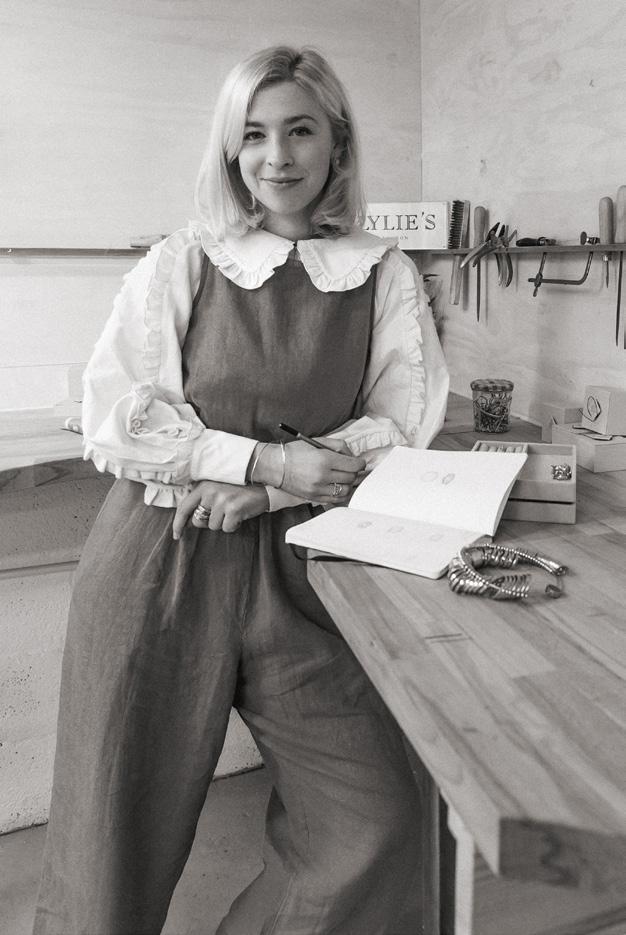
A dditionally, Lylie offers customers the opportunity to recycle their hallmarked gold, platinum, or silver jewellery, for which they will be given a credit note to purchase a


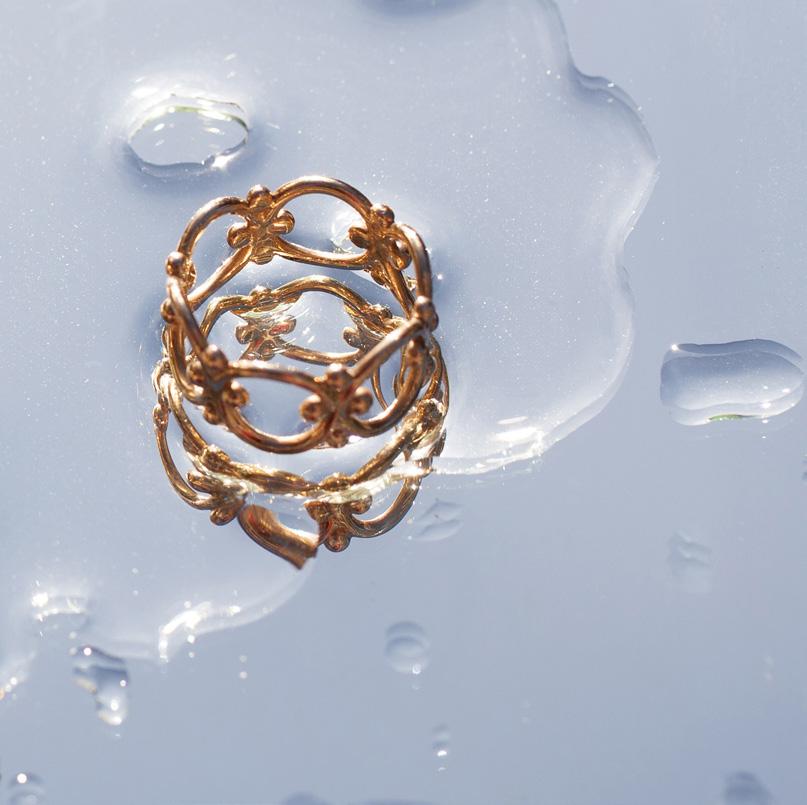


new piece from the brand. The value of this credit note is dependent on the value of the metal at the time of the exchange, as set by the London Bullion Market. That price fluctuates daily, so in a further effort to incentivise recycling, Lylie offers 7.5% above the metal’s market value.
“Our landfill sites are hidden goldmines,” states Walter. “If you were to mine one ton of the earth's ore, you would get a yield of under 30g of gold. If you were to mine one ton of e-waste, you would get a yield of 300g of gold. To extract the gold in e-waste, you have to access the mother board. This means other parts of the waste (ceramics, non-precious metals and plastics) are recovered, sorted and recycled in the process. Whilst its scale is daunting, e-waste offers an immense opportunity. Entrepreneurs, academics, and business leaders need to address the dismantling and re-use of e-waste components as an urgent concern."
Opening pages, from left to right: Lylie SS18 collection; Lylie recycling e-waste, both by Chloë Winstanley Opposite page: Chopard's responsibly-sourced paraiba tourmaline; making of Chopard's Green Carpet Collection This page: all Lylie
31
Above: Lylie founder, Eliza Walter
Watch and Learn

32 AIR
WORDS: JOHN THATCHER
From recycled steel and fishing nets to compost straps and ocean protection, the watch industry is aware that it’s time to take action

33 Timepieces APRIL 2023: ISSUE 139
Sustainability in the watch industry is manifest in multiple strands. It’s a fact that its most coveted brands, the likes of Richard Mille and Patek Philippe, produce limited quantities that will likely last a lifetime (as their well-known advertising copy outlines, ‘You never actually own a Patek Philippe, you merely look after it for the next generation’) and are therefore the very antithesis of disposable consumption.
Both brands are also popular on the global second-hand watch market, which, though it has dipped from its peak of 2021 alongside other asset classes, is currently worth nearly US$21.7 billion, according to Deloitte. It’s a market that includes sales at traditional auction houses, but also one fuelled by a younger generation who want luxury goods and are also sustainability-minded in their purchasingshabits.

These same buyers are the reason why some other brands have turned to using next-generation materials in their timepieces. Panerai were one of the first to do so, nailing their colours to the mast of sustainability with 2021’s reveal of the Submersible eLAB-ID™, a concept watch that at the time contained the highest percentage of recycledbased material ever assembled for a timepiece – a total of 98.6% of its weight, with materials drawn from industries including aerospace and automobiles. It then introduced eSteel™ to its wider production cycle, a metal derived from recycled steel scraps, preferably those from the Swiss watchmaking industry. It debuted on a trio of Luminor Marina pieces, each with a rubberized crown and a recycled PET strap. And more recently was used for the Submersible collection of diving watches. By 2025, Panerai estimates that 30% of its output will be designed and produced using recycled materials.
U lysee Nardin is another brand making use of recycled materials. Limited to 29 individually numbered pieces, its latest Diver Norrona Arctic Night timepiece not only features Carbonium®, a high-performance composite material, of which 95% is eco-sourced from carbon by-products, but also recycled fishing nets.
Then there is circular economy devotee ID Genève, winner of 2021’s The Luxury Innovation Award. It was launched the
previous year by a trio comprising a watchmaker, designer, and entrepreneur, who wished to change things by eradicating the need to further extract raw material. To that end, ID Genève is the first brand in the watch industry to manufacture pieces from 100% recycled steel using a solar furnace. This waste steel all comes from the Jura region, further, and significantly, reducing its carbon footprint.
ID Genève uses only fully refurbished certified movements, with oscillating rotors recovered and skeletonized to remove their former markings. What’s more, its straps are produced from 100% green waste, such as vegetable compost, and its homecompostable packaging is formed from either seaweed or mushrooms. This being a Swiss-made watch, reliability is also a key factor. When purchasing an ID Genève timepiece, customers are given so-called Circular Coins, a virtual currency they can spend on the upkeep of their watch.
Breitling has looked to its sourcing of traditional materials to showcase its sustainable credentials. Chopard were pioneers in the use of 100% ethical gold, joining the Swiss Better Gold Association back in 2017 and committing to its exclusive use the following year. Now Breitling has announced its intention to follow suit,
stating that by 2025 its entire product portfolio will feature ‘better’ gold and lab-grown diamonds. Showing its hand early, last year the brand released The Super Chronomat Automatic 38 Origins, which featured examples of both. It is also Breitling’s first ‘traceable’ timepiece, each watch sold with its own blockchain-backed NFT, outlining the provenance of its materials. “As an advocate for sustainability, I believe in this watch’s mission,” said its ambassador, two-time Olympic gold medal-winning snowboarder Chloe Kim. “We all have a responsibility to question where our products come from and to put a preference on brands that go the extra mile to source ethically.” W here most brands find common ground – or water, as is seemingly the case – on the subject of sustainability is ocean conservation. Breguet is the main partner for the Race for Water Foundation, which is committed to tackling the problem of highly polluted waters, while the likes of IWC and Rolex are engaged in various undertakings, the former teaming up with the Charles Darwin Foundation in its fight to preserve the ecosystem of the Galapagos Islands.
But it’s Blancpain that leads the way here, paying homage to its now legendary Fifty Fathoms diving watch by lending its considerable weight to supporting a wide range of initiatives aimed at tackling the multiple issues facing our oceans. For this, Blancpain has teamed up with passionate divers, leading scientists, underwater explorers, environmentalists, and photographers. Its commendable efforts are divided across the key pillars of awareness, exploration, and preservation. The latter includes The Protectors, a campaign Blancpain launched in collaboration with The Economist Group to have 30% of the planet’s oceans classified as marine protected areas by 2030 – a commitment since set in stone by last month’s historic High Seas Treaty. In 2014, the brand also issued the first in what’s now a three-strong series of limited edition – 250 pieces – Fifty Fathoms Ocean Commitment watches, donating part of the proceeds from their sales to further support its ocean initiatives.
It seems as though it’s only a matter of time before sustainability is the chief consideration for all in the industry.
34 AIR
Opening pages, from left to right: Blancpain Fifty Fathoms Ocean Commitment III; Female Fifty Fathoms Award photography prize entry
Opposite page: The Super Chronomat Automatic 38 Origins, Breitling This page, clockwise from above:
Circular 1, ID Geneve; Submersible
QuarantaQuattro eSteel™, Panerai; Diver Norrona Arctic Night, Ulysse Nardin



35
‘
ID Genève uses only fully refurbished certified movements’



A TAILORED EXPERIENCE
Bespoke. Tailored. Luxurious.
Welcome to Bulgari Lighthouse Dubai.

From the always-on concierge to the expansive in nity pool and Mediterranean gardens, our beautiful 4 to 5-bedroom luxury penthouses promise a highly private and personal living experience. The Bulgari Lighthouse Dubai's beautiful and considered design, re ects the Bulgari values of unrivalled craftsmanship, thoughtful precision, and timeless elegance.


Visit bulgarilighthouse.com
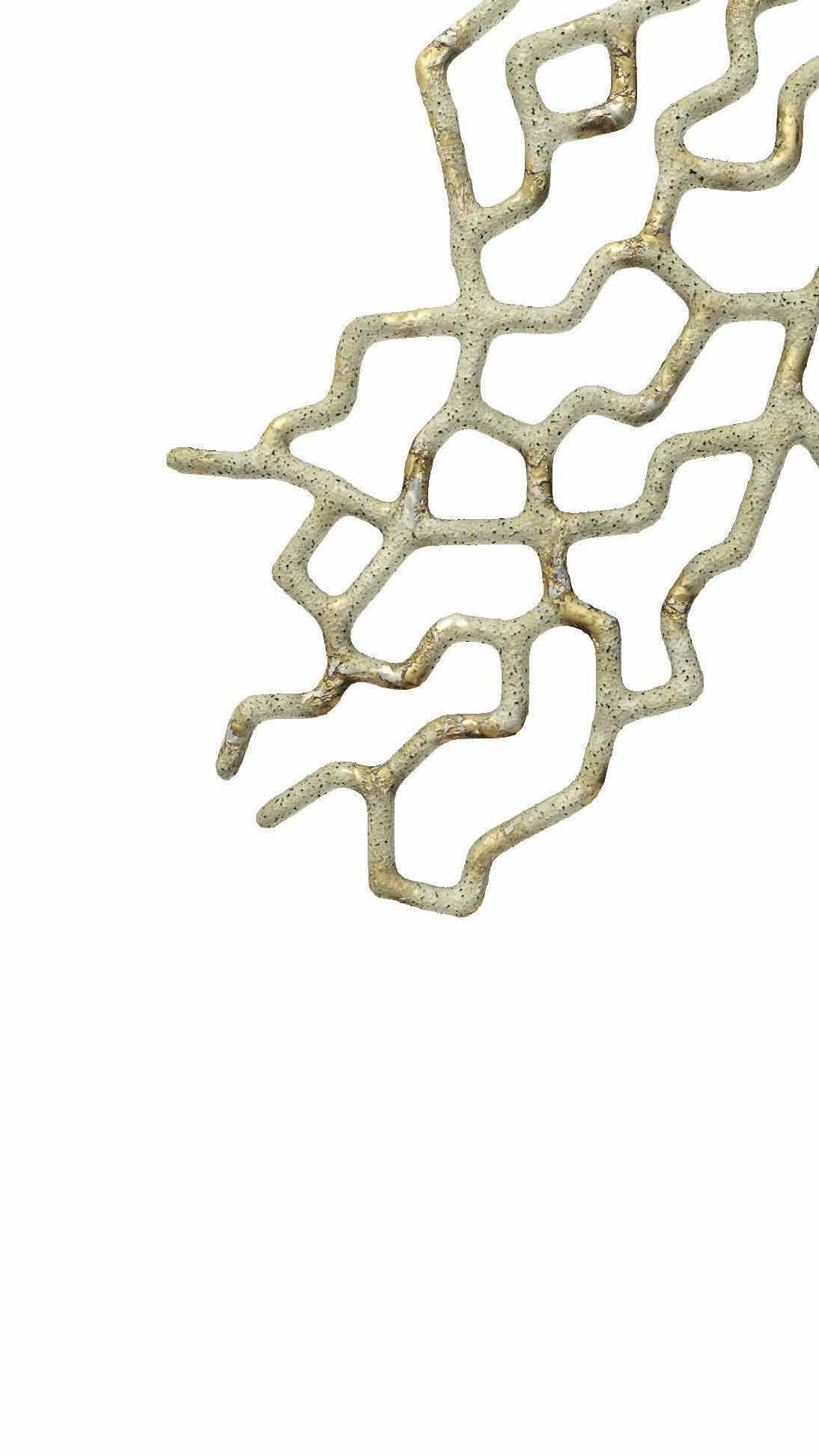

36 AIR
WORDS: JOHN THATCHER
As the world’s first sustainable couturier, Ronald van der Kemp is pioneering change at the pinnacle of luxury fashion
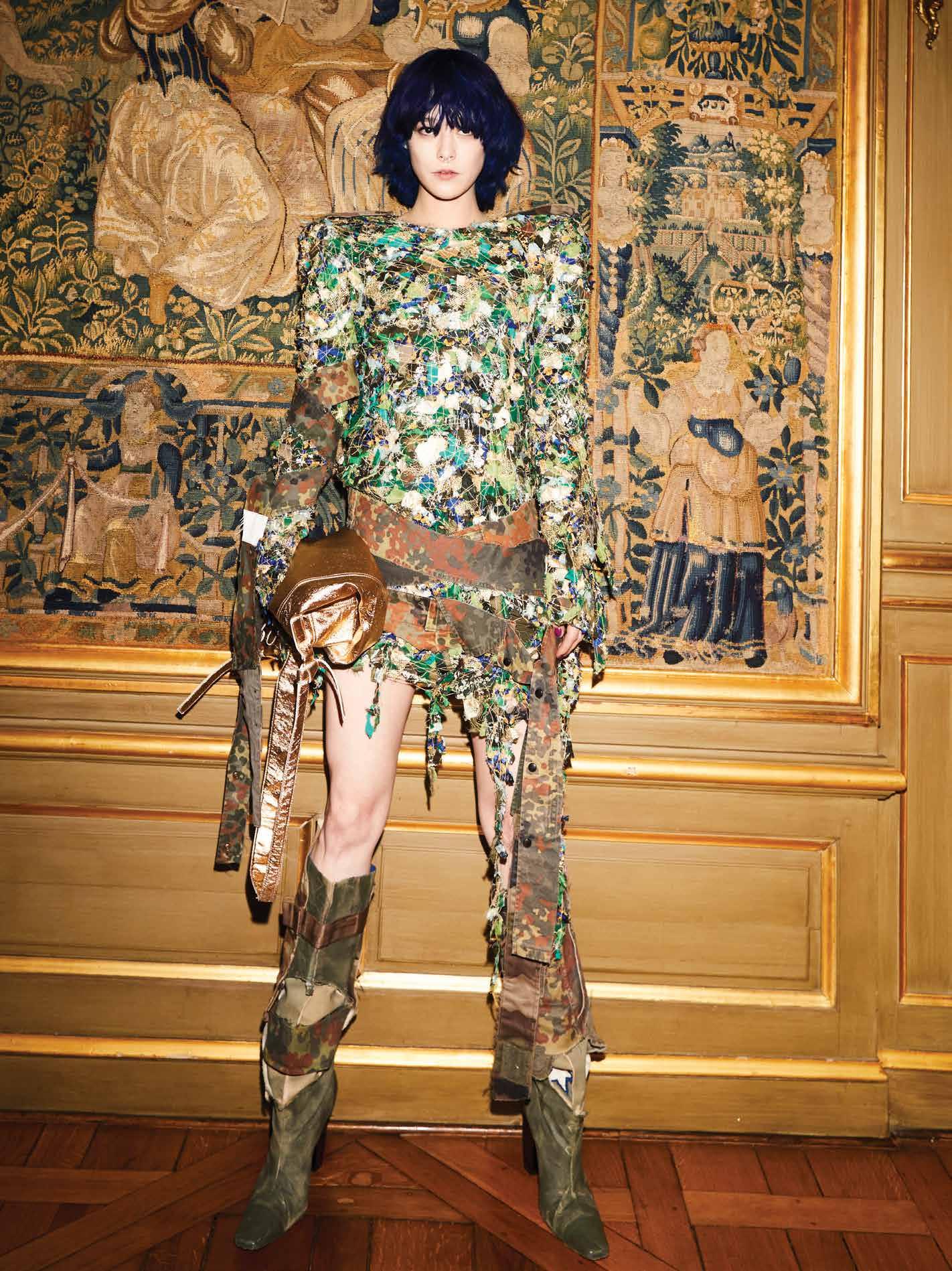
37
Ronald van der Kemp has his camera switched off for our interview over Zoom. In place of his face is his name, emblazoned across the top half of my screen, which is rather apt. Because right now his name deserves to command our full attention.
The Dutch designer is the man behind RVDK, the world’s first sustainable couture label, through which he is fighting the good fight for change in an industry in desperate need of it, a fight for which new recruits are badly needed.
It’s widely known that the fashion industry is one of the largest polluters of our planet, second only to the oil industry. At the root of it is over consumption — we’re buying things that we simply have no need for, and we’re buying them because they are being made.
It is reported that this year, fossil fuel energy will facilitate another 120 billion new garments and 20 billion new pairs of shoes entering the already swelled global marketplace. At the same time, a report by Bloomberg estimates that the United States alone discards up to 11.3 million tons of textile waste each year, which boils down to a figure of some 2,150 items of clothing each second. It’s an eye-popping statistic, yet many other rich nations aren’t far behind.
This is why sustainability in fashion needs to be so much more than a trend.

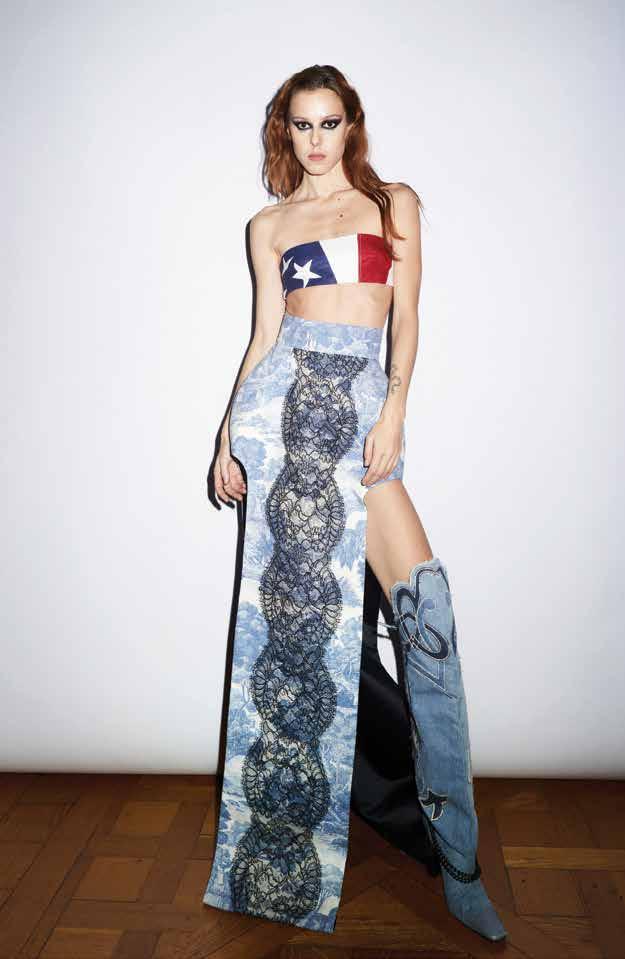
“You see some brands do things like a small sustainable capsule and blow it up into something big, or stage a show that is carbon neutral. What does that mean, you plant some trees? The problem is with the amount of clothes being produced,” laments Ronald.
“It’s not that I think we shouldn’t buy clothes, on the contrary. I talk about responsible hedonism. People want to look good, feel good, and have fun. Me too. But let’s do it in a way that makes sense in this world.”
What makes sense to Ronald is a return to a time when a woman would gradually build up the perfect wardrobe, carefully selecting pieces and designers that helped accentuate their personal style. A time when “luxury fashion was still a deeply intimate affair.”
How far removed are we from that time? “In terms of fast fashion, there
are people who will buy things just for a moment, something that they will wear that evening and very easily throw away the next day, because some of those clothes are so cheap. But what I find really weird is that I now see the same thing happening at the luxury level.
“I’ve always worked in luxury fashion and right now I see that the demand for newness is so strong. You used to find that women who bought couture were real collectors, they understood what they were buying. But now the audience is a little more nouveau riche, and I think some of them just buy items because of the label.”
Born in Wijchen, Netherlands, in 1964, Ronald spent twenty five years working for luxury brands including Bill Blass and Celine, where Michael Kors was creative director. He’s always loved fashion, but came to question how the system operates.
“Because new collections come around so quicky, you need to be very structured, following the same formula every season to the point that I felt it became a case of simply filling in the blanks each time. There was no time to develop an idea or to be creative, which is not how I like to work. Then I began to wonder where all these clothes go if they’re not sold, and started to hear stories about clothes being burnt. I thought, what’s going on here? This is not the world I want to live in; this is not what I want to contribute to.”
The defining moment that would determine what Ronald did next came during a trip to New York, to where he was sent to check out what competitive brands were selling in their stores. “The last store I entered sold
38
‘
If you want big money you shouldn’t do what we are doing. I’m doing it with a purpose. I see myself as a man who wants to change the world ’
AIR

39
Photo : Alan Jensen
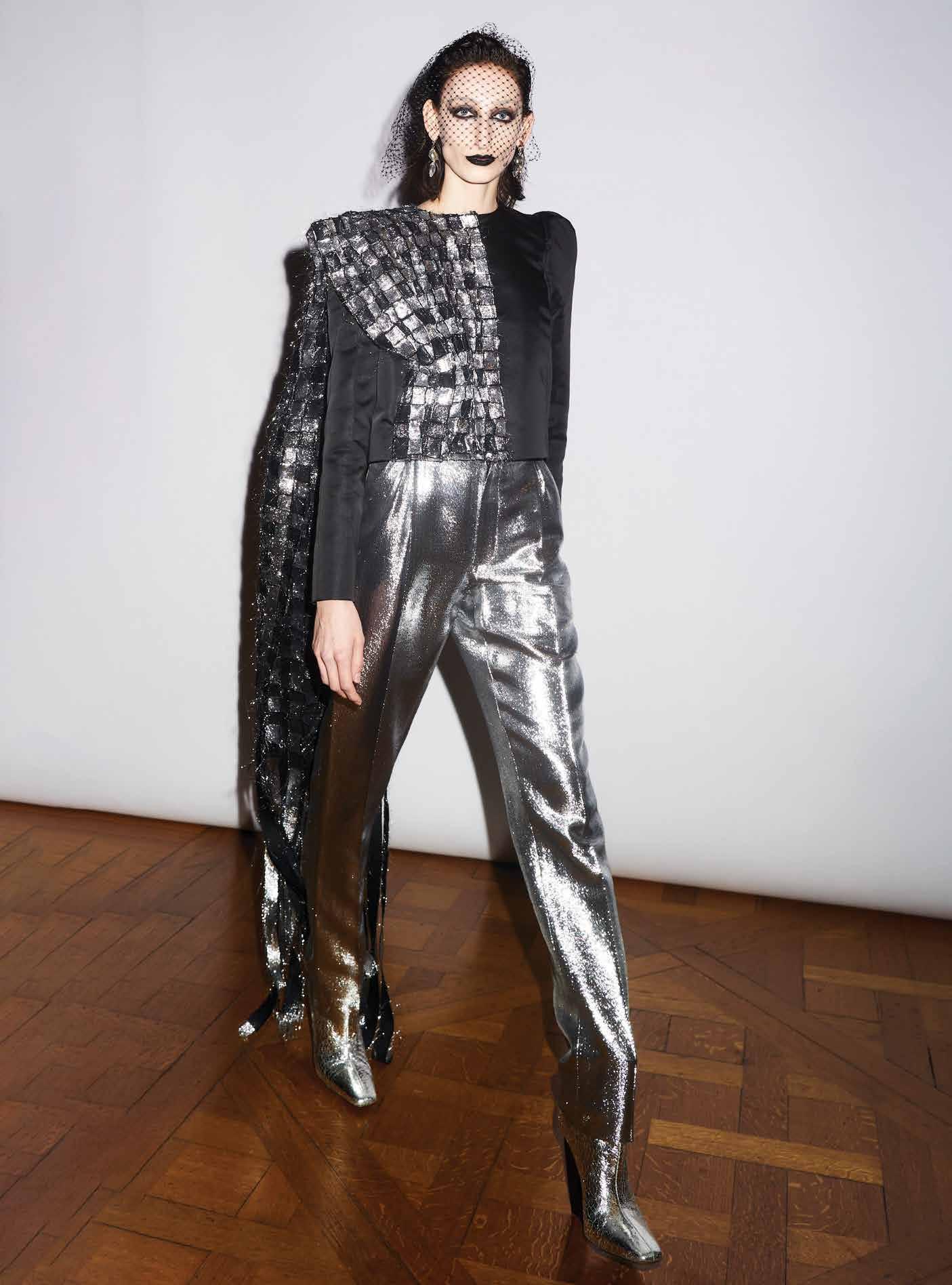
40 AIR
vintage couture. It made me realise that these are the pieces that matter, not the hundreds I saw in the stores throughout that day. It’s not that those other clothes weren’t perfectly made, but there was something missing. I felt that the couture pieces had a soul. The fabrics were beautiful, you could see the little imperfections because they were made by hand, and you were aware of the time spent making them. Those clothes really spoke to me. And I decided then that these were the clothes I wanted to make.”
As a member of The Fédération de la Haute Couture, RVDK shows during Paris Couture Week, staged in January and July. Ronald must make a minimum of twenty five pieces per show, and tasks himself with ensuring that each is made only from high-end unused and leftover materials. “They come from everywhere — from flea markets and offcuts to prints that were made in really small quantities for couture brands in the 70s. Also, a lot of the big labels buy so much fabric and use only a small percentage of it. Before they used to discard the rest, but now they see there is a market for it and look to sell it.
“At the beginning it was difficult for me to find materials, but not now. There are so many leftovers in this world.
“The fact that we work with all these materials that are sometimes in very small quantities, enough to maybe make only one dress, makes it exclusive. We work in this very unique way, so someone can end up with a piece that no one else in the world has. It’s pure exclusivity.”
RDVK was launched in 2014, a time when the idea of sustainable clothing was far from glamorous, and even further from the world of haute couture.
“When we started out there wasn’t anyone doing it like us, because when you saw sustainable clothes at that time they really looked sustainable,” remembers Ronald. “They just didn’t look very attractive. I’m a real fashion person, I love it, and I grew up with a love for the old couturiers like Yves Saint Laurent. That is my culture, my language, so even though my clothes are sustainable I just want people to consider them as clothes first and foremost. It’s
just nice that they have the extra layer of our story behind them.
“Sometimes I feel like a little dog up against dinosaurs,” he says, when comparing the size and resources of RVDK to the conglomerate-backed heavyweight labels. “But we still have a voice and I think the people in the know really respect what we do. They see the things that have changed in the industry, partly because of what we do. For example, the word ‘upcycling’ didn’t exist before we started this whole thing and now it’s a very common practice, particularly among the younger generation. We’ve always shown that sustainability can be glamorous and sexy, and I think people understand that we’ve helped change the perception of it. For that, we do get a lot of respect. But, of course we cannot compete with the fashion conglomerates. We have less than 1% of the budget for a show compared to a brand like Valentino, but we still manage to do something interesting. Working with the restrictions we have is what inspires me most.”
Ronald talks passionately of how the industry needs to find new ways of doing things, including how it showcases collections. “A lot of fashion shows aren’t even about the clothes, they’re more about who’s sat on the front row or who’s walking the runway. It’s all about the context, and if that’s the case, then maybe show clothes that you have already shown but in a new, creative way [RVDK has previously done so]. Just think of something else other than making new clothes all the time. We need to reinvent the system, but the trouble is there’s so much money involved.”
During the height of the pandemic in 2020, when all other couture houses
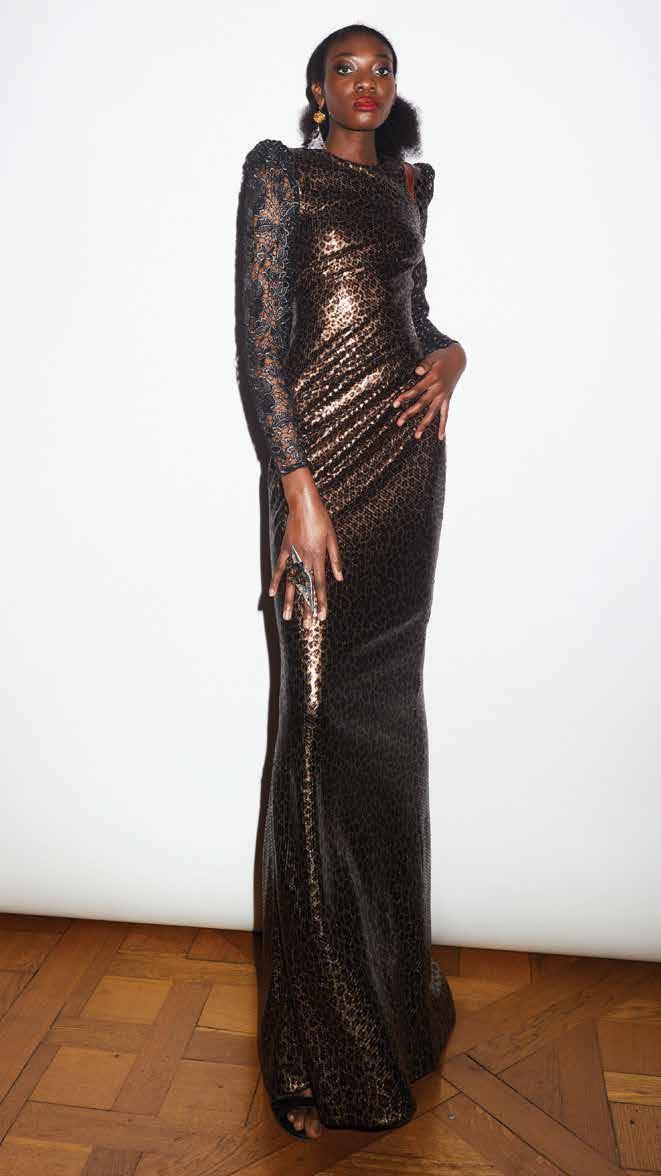

41
‘ A lot of fashion shows aren’t even about the clothes, they’re more about who’s sat on the front row or who’s walking the runway’
Previous page: Ronald van der Kemp All other pages: RVDK Haute Couture Spring/Summer ‘23
wondered what they should do next, RVDK dressed 29 models in couture dresses, each wearing a couture mask that matched their dress [the masks were later auctioned by Christie’s]. The models were confined to their own rooms at Hotel Europe in Amsterdam, where they took to the open windows to wave white flags. The statement was: “If you can surrender to covid, you can surrender to sustainability.”
It garnered global attention, including an article in the Wall Street Journal , and sparked talk inside and outside the industry of the need for change. We’re still waiting for it.
“During the pandemic, I heard the same story over and over again from brands — we’re going to do only two collections a year, or we see the problem now and we’re going to change things,” recalls Ronald. “But once the pandemic ended the whole thing went back to how it was before. They missed the boat. In fact, it’s now worse than it was before, so this is really disappointing to me.
“I think there are efforts, but the problem is growth. If a brand keeps growing it keeps producing more clothes. All the big fashion groups should take responsibility, especially with the huge profits that they make, and support brands like ours, but obviously they don’t because if they link themselves to a brand like ours then they’re admitting that the things they do are wrong. The whole system needs to change.”
LVMH did of course buy Stella McCartney, a label that prides itself on its commitment to sustainable practice, and McCartney has spoken of being an agent for change within the industry.
Can Ronald see RVDK going the same way? “That would be very difficult. We really want to stay true to what we stand for, and if we wanted to scale it up it would be very difficult. If you want big money then you shouldn’t be doing what we are doing. I’m doing it with a purpose. I see myself more as a man who wants to change the world.”
A more level playing field for RVDK is celebrity dressing. “The first person that we dressed was Kate Moss. It’s not something you make money from, but when people wear our clothes they become ambassadors for a good cause, the message gets out there.” Michelle
Obama and Sheikha Moza bint Nasser have also worn RVDK. “When Gigi Hadid wears something, or Kendall Jenner, and young girls see it’s our clothes, then they learn our story. For me, that’s the most important thing.”

Given the prices of its couture pieces, young girls are not RVDK’s target audience, but Ronald hopes that they’re inspired by the idea of ‘wardrobe building’.
“If you know who you are, what you stand for, and if you have a certain personality, you should collect clothes around that personality. You don’t buy things that you’re going to throw away, you start to care for and build a relationship with your clothes. At our shows we always like to have very different personalities, not one type of person, because everyone has their own look, their own personality, and I feel this is very important. If you have a wardrobe that’s reflective of you, you know you’re always going to look good.”
Has the RVDK client changed since the label’s launch? “I think our customers are now aware, or they at least talk about it [sustainability]. Whether they actually do what they say is another thing. But the awareness is definite. Now we also have customers who don’t really know exactly what we do, they just like the clothes, and that’s fine. They’re still ambassadors for our story without knowing it.”
With emerging design talent now more eco-conscious than their predecessors, what advice would Ronald offer someone keen to follow in his footsteps? “I don’t think you should follow in anyone’s footsteps,” he says bluntly. “It’s important that you follow your own path. I always try to motivate people to think like this, because once you fall into the trap, or get swallowed up by one of the big fashion groups, you’ll be forced to work their way. Don’t follow the system; try to find
your own way. I feel that’s the only way for the fashion world to change.”
Is he hopeful that change will come? “Very hopeful, because we’ve already shown that change is possible by propelling the idea of upcycling into the industry. I always try to stay positive because there’s no point in only talking about everything that’s wrong, you also have to show what can be done about it, and come up with new ideas. That’s what we’re trying to do each and every day.”

AIR 42
‘ All the big fashion groups should take responsibility, especially with the huge profits that they make’
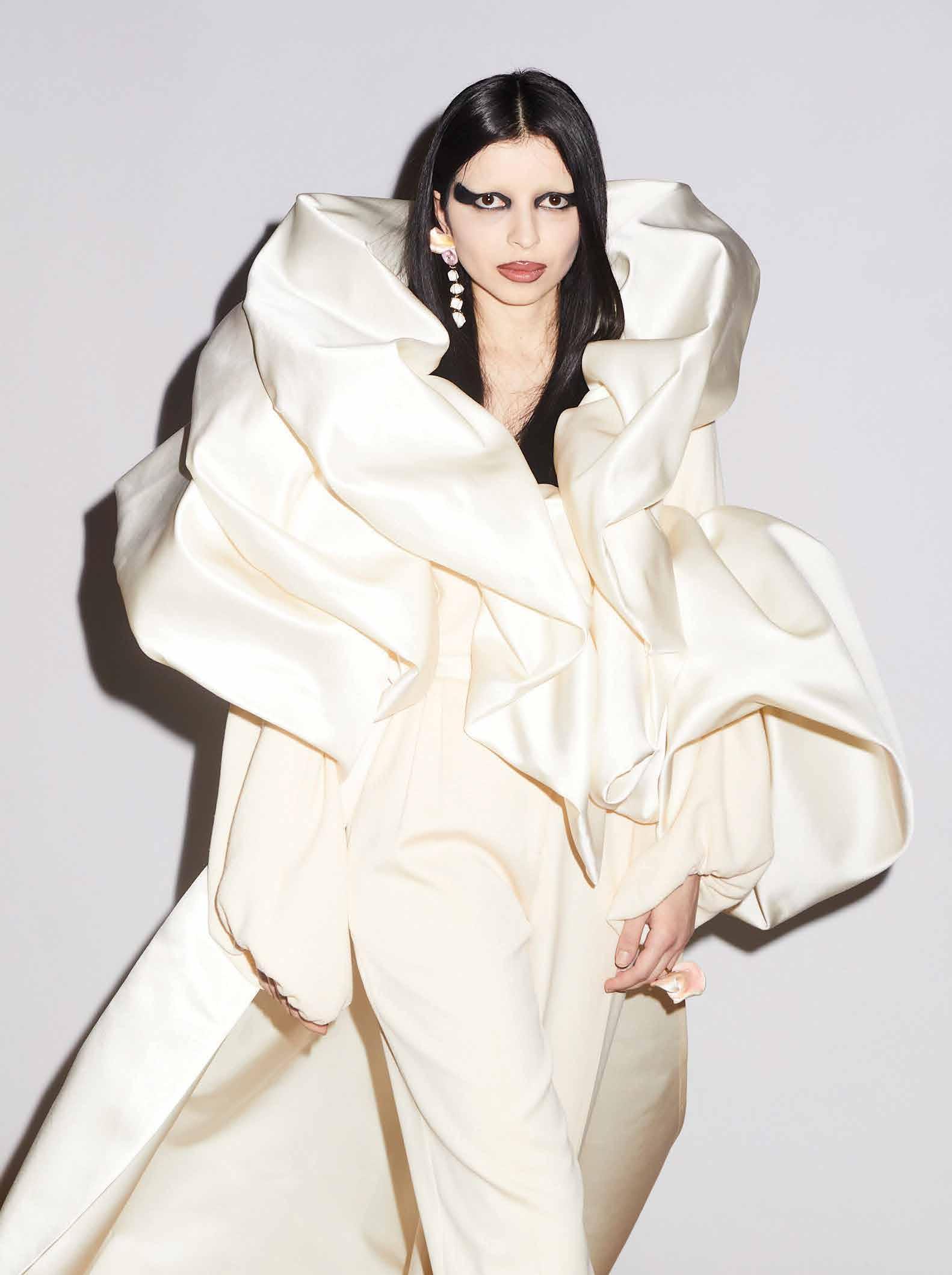
43
How the opening of the first Upcycling Couture Salon in Paris not only gives new life to barely worn clothes but to the people who repurpose them
44
AIR
WORDS JOHN THATCHER

45
The sight of supermodels Naomi Campbell, Shalom Harlow and Irina Shayk shimmying down the catwalk with the head (teeth and all) of an actual ‘big cat’ protruding from their chests — albeit lion and tiger heads fashioned by Schiaparelli from foam and silk faux fur — naturally hogged the headlines during January’s Haute Couture Week in Paris. But it was a much smaller event held later that same week that will hopefully make a more lasting impression on the fashion industry.
The event was scheduled to announce the opening of the first Upcycling Couture Salon, a made-to-order atelier that gives couture clients the opportunity to breathe new life into clothing they have always loved and preserved but no longer wear.
“Someone may wear an haute couture dress only one or two times, after which they’re stuck for an idea of what they can do with it,” says Philippe Guilet, President and Artistic Director of Renaissance, a Paris-based, not-forprofit organisation founded in 2018. “Now they can bring that dress to us and we will deconstruct it, working with them to create a new outfit. We don’t want to follow or set trends. We’re just interested in making clothes that can be worn on a daily basis.”
In addition, Guilet believes such a process will help couture clients answer uncomfortable questions about waste and value, particularly those posed by their own children, a generation that’s overtly aware of the damage caused by the fashion industry as a whole, which discards a reported 92 million tonnes of textiles each year.

The opening of the Upcycling Couture Salon is another important step for Renaissance, whose work is now recognised by the Fédération de la Haute Couture.
Since 2018, it has upcycled luxury garments handed over by both individuals and fashion houses, making use of clothes that would otherwise end up in landfill. Notable examples include the deconstruction of a Sonia Rykiel dress and pair of Yohji Yamamoto cargo pants, subsequently transformed into a contemporary outfit worn by Ashley Park in the second season of Emily in Paris . And a 15-piece collection for Alaïa, made from their stock of unsold garments.
“There is a long road that must be travelled, but the journey is in progress,” says Guilet of fashion’s pathway to meaningful sustainable practice. “We meet with fashion houses on a regular basis, to look at how we can utilise their unsold stock, and have previously produced a sold-out
capsule collection in this way. We can be a solution within the industry.”
Guilet’s own pathway to his current position at Renaissance weaves its way through fashion royalty, working as an assistant to Karl Lagerfeld and for Thierry Mugler, Perry Ellis, Donna Karen, and Jean Paul Gautier,
AIR 46
Above: Philippe Guilet
‘ We can be a solution within the industry’



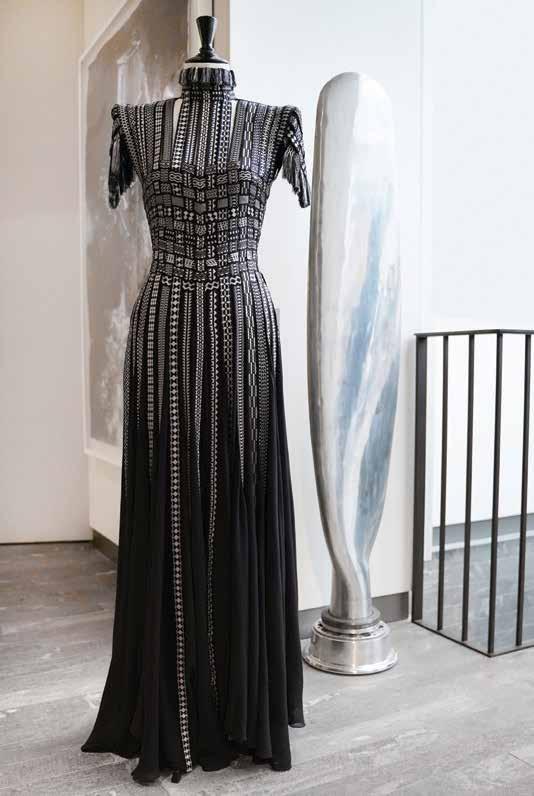
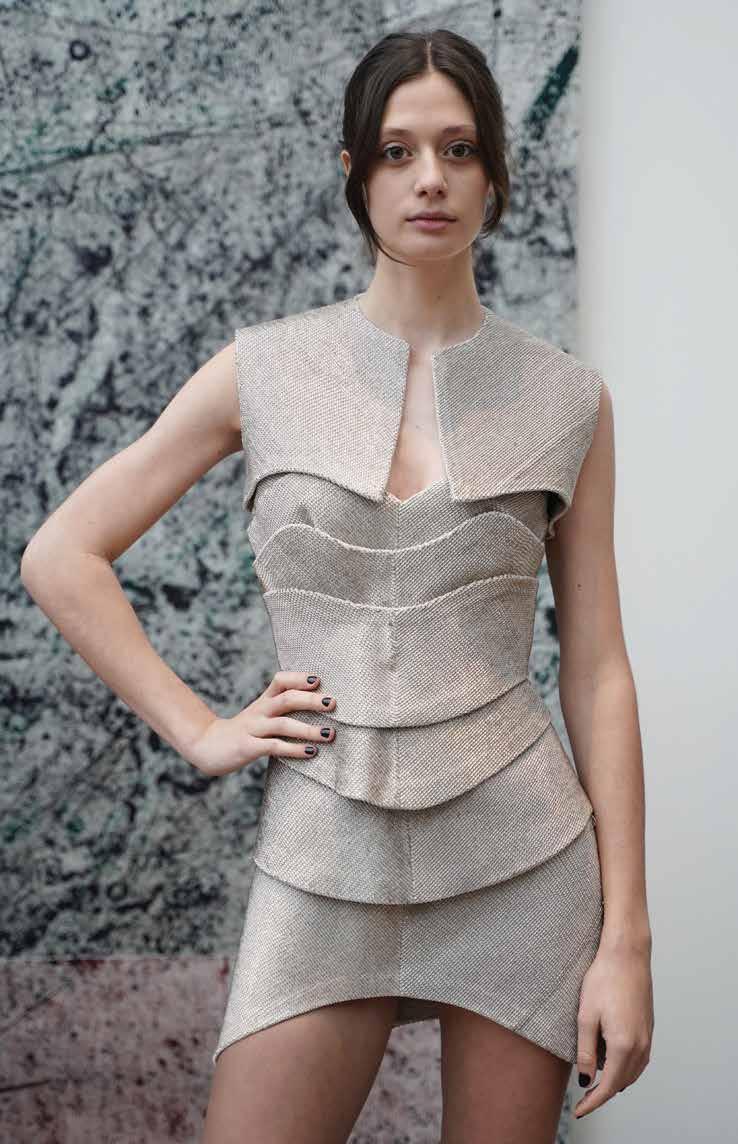

47

48 AIR
where he was research director.
But the story of Renaissance also includes a key chapter on Romania, to where Guilet headed at the turn of the last decade to work as artistic director for the French Embassy.
“In Romania I did what I really like to do — discover talent.”
He discovered it in abundance, most notably in the country’s northern region of Bistrita Nasaud, where centuries-old Romanian handicraft is still practiced, the ornate embroidery skills of its female artisans passed down through generations. To this day, the tools they utilise date to the 16th century, including bone needles, used to embroider sheepskin.
“Romania is often derided, but actually this country is quite the opposite of what people might think,” Guilet, who spent many years
in the country, said at the time. To broadcast these ancestral talents to a wider audience, Guilet launched a cultural project called 100%.RO, which birthed a clothing line, Prejudice, to which fifty local artisans contributed. “Philippe has come from afar and appreciated the value of our skills. It is extraordinary that he has showcased our work,” said Virginia Linul, one of the artisans involved. “Nobody has done this for us before,” she told Reuters.
Guilet then returned home to France with a choice: whether to enter another fashion house and continue his impressive career alongside another stellar name, or, in his own words, “to help people.”
Spurred by an article in Le Monde that was critical of the excesses of couture — unfairly, thought Guilet, when there are bigger issues in the industy — Guilet decided to indulge his twin passions for couture and people.


The aim of Renaissance is actually twofold: to upcycle luxury readyto-wear and haute couture clothing and to reintegrate unemployed people into the workforce.

Just as he did in Romania, Guilet has found an outlet for the expression of talents that would otherwise fly under the radar.
Convinced that the suburbs of Paris held untapped potential, Renaissance partnered with organisations like Cercle la Ressourcerie, who specialise in social integration. It helps people who, for whatever reason — no formal
qualifications, have suffered an accident, are new to France, or had to care for their children – are unable to access the traditional job market.
Over a 12-month period, these men and women, drawn from diverse backgrounds and myriad countries — Afghanistan to Brazil — are taught haute couture know-how and its time-honoured methods, leading to the presentation of a collection at a final fashion show.
The money Renaissance receives — a mixture of donations and government support — is reinvested in equipment for the workshop. “I see Renaissance as a little house of couture,” enthuses Guilet.

By helping people learn or develop their skills, Guilet also thinks a larger, thriving Renaissance can help the fashion industry tackle another problem it is facing — a shortage of skilled people. “Within the workshops of fashion houses there is a crisis, as they can’t find people with the knowhow do to what is required.”
Guilet tells me of one particular Renaissance graduate who was subsequently taken on by Saint Laurent. “Wonderful news,” he says, his face alight with the joy of a proud father.
“I’m a very optimistic person, and I want Renaissance to grow and grow, so that we can do something good for the planet and for the people who work here.”
Rewarding such optimism is a necessity.
49
‘ We can do something good for the planet and for the people who work here’
Ever since launching her eponymous label in the early 1990s, Stella McCartney has been a pioneer of alternative materials and ecofriendly practices. It’s serious business
WORDS: LISA ARMSTRONG
50
AIR

51
For Sir Paul McCartney’s 80th birthday last year, daughter Stella bought him a sophisticated form of DIY prezzie — a set of her organic, vegan skincare range. As if we hadn’t guessed, Sir Paul can be tricky to buy for. “He positively mourned the passing of my first skincare line,” she declared.

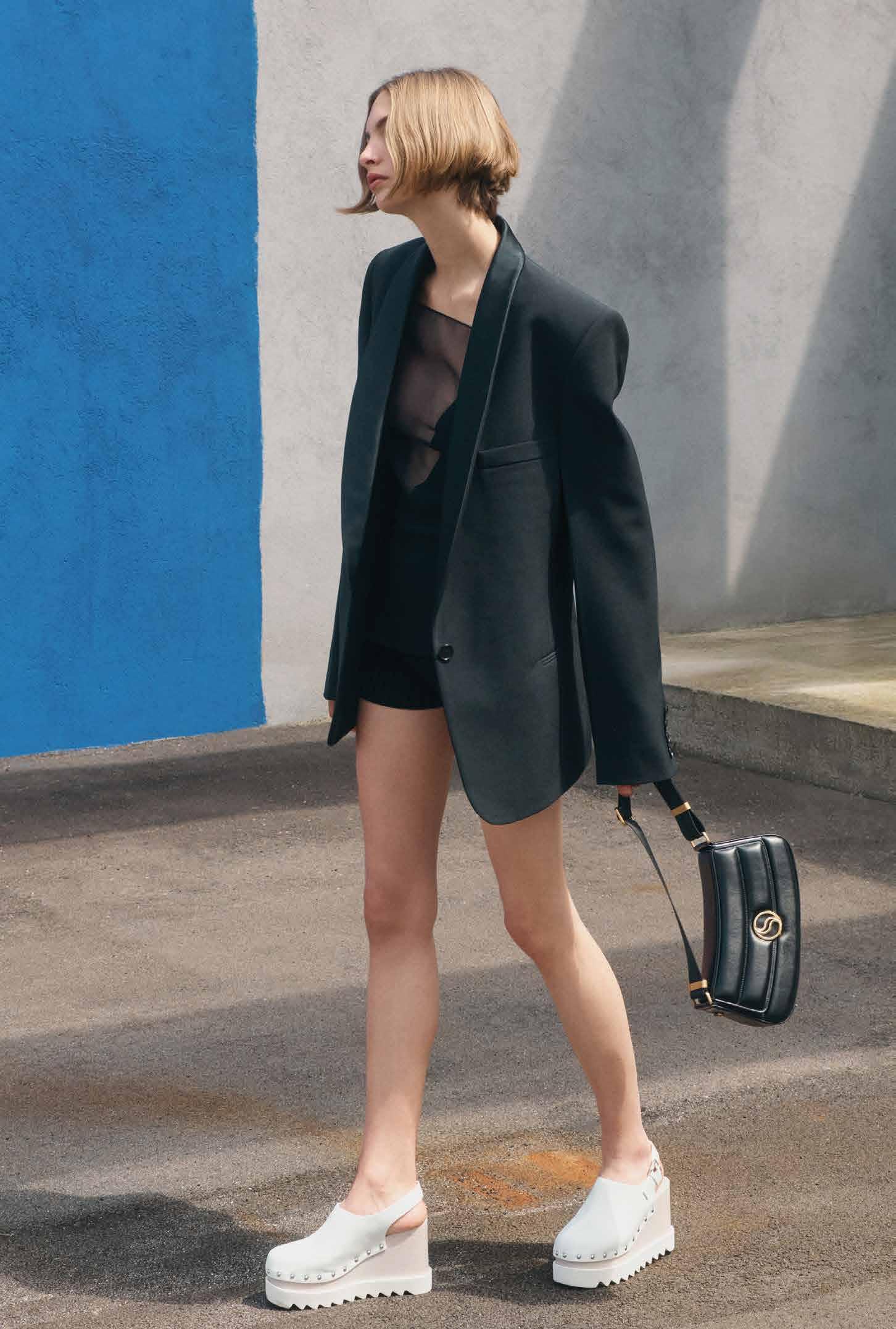
That first foray into beauty was 16 years ago and the landscape has changed dramatically since — an evolution for which Stella is entitled to take some credit. The first designer to bring an organic, animal-friendly line of beauty products to market, she had to fight. “No one really knew where to place it,” she says. It sat in wholefood stores — not very glossy — and proved difficult to scale up and export. But if it was short-lived, its legacy is that paraben-free, sulphatefree, vegan and non-toxic skincare is now commonplace. So much so, I wonder whether she’s concerned the market’s already saturated.

“Yeah, there’s a lot out there,” she agrees, sinking gracefully into the low-slung, 1970s, dusky pink Mario Bellini sofa (whom she collaborated with for a sutainable furniture line) on the first floor of her Bond Street store.
There’s nothing that Stella loves more than a project, especially if it involves a house and a garden. “I’ve never bought a house that wasn’t falling apart,” she told American Vogue back in 2010, when they featured her remote Georgian pile in 277 acres of Worcestershire that had been reduced to a series of grungy
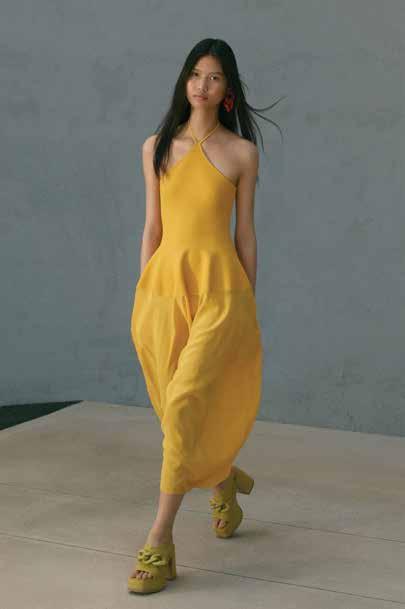
52
AIR
bedsits when she and her now-husband Alasdhair Willis bought it in 2003. But back to beauty. “To get what I want currently — pure, organic, effective — I have to shop across ranges. Whereas my line is so simple. Just three products”. A cleanser, a serum and a moisturiser, all in refillable packaging. There’s no eye cream because she doesn’t bother with it and the serum does it all really, she says. McCartney doesn’t always use sun cream either.
“The problem is so much of it is terrible for the planet. So then I think, OK, just stay out of the sun. But then it’s like, the sun feels so good, so maybe just for a couple of minutes, just for the Vitamin D. I’ll probably end up a very gnarly 80-year-old. Ideally though, I’d rather not be gnarly”.

That surprises me because I thought she’d say she’d like to end up like US writer Joan Didion. At 51, McCartney still retains that effortless cool, slightly boho-but-tailored style that she helped make synonymous with London in the 1990s, but which in part came from her American mother. Then again, she always looked more groomed than the average London girl. When we meet she’s in denim, a blazer and strappy sandals, her distinct russet mane as vivid as ever. There’s no nail varnish, artful make-up — more than she normally wears, she says, because she’s being photographed. Although she has an identifiable style, it’s never been fixed. Her collections often do a volte face — sporty utility one season, romantic the next. “My problem is I love everything — minimalism,



53
‘ Everything I’ve done has been because I couldn’t find it in quite the way I wanted it ’

AIR 54
monochrome, colour, glitter...”
Growing up, artifice was on the back burner. The McCartneys split their time between the Sussex farmhouse and Kintyre in Scotland. In 1969, a Life magazine cover (now framed in one of Stella’s loos) fan-fared the case of 'The Missing Beatle', having tracked Paul and Linda down on their remote Scottish farmstead. “I think my childhood in Scotland was where I felt cleanest,” Stella says now. “It was so… natural. We were always naked. My parents didn’t even wear deodorant and yet they never smelled.” A rare aberration in this clean-living paradigm was the foaming Clarins Cleanser that Linda gave her daughter when she was about 13. “It was everything I now know is bad about skincare… but it was the 1980s”. And it set her on a quest for skincare. She might be laid-back, but she diligently tends her skin. Failing to appreciate, as kids do, her mother’s low maintenance approach to beauty, teenage Stella begged Linda to wear make-up. “In fact I did her make up for her. She was into it, but it wasn’t an obvious presence. There’s a McCartney rose. We’d grow loads of them and my mum would have it made into essential oils. There were a lot of essential oils.
“I’d also nag her to wear all the fabulous clothes she wore on tour, and
her jewellery. She had such beautiful jewellery, but she never really wore it. And now — look at me.” She thrusts out her arms to display... nothing, apart from a tiny gold evil eye bracelet.

“I found it on the floor of my dad’s house, so if you visited him there and you’re missing an evil eye, I’ve got it.”
Her parents inspired everything she does, but now she also leans into her children, aged 11 to 17, listening to their concerns about the planet and looking for solutions. “Everything I’ve done — kids’ wear, vegan shoes, mushroom leather bags, organic, certified fabrics — has been because I couldn’t find it in quite the way I wanted it. There’s no other line of beauty that’s as clean and luxurious, with all the active ingredients, as this one.”
Nor, she could add, with the distribution. Because this time round, she has the backing of LVMH, the luxury behemoth that also owns Celine, Dior, Fendi. Loewe, Louis Vuitton, Tiffany, Loro Piana, Celine… and Sephora, the global chain of beauty stores.
Selling a minority stake, in 2020, to LVMH, the world’s largest luxury group, was a surprise move. Seventeen months earlier, she’d bought back 50 per cent of her company from the Kering Group, France’s other, slightly smaller luxury behemoth (Balenciaga, Gucci, McQueen…), amid speculation



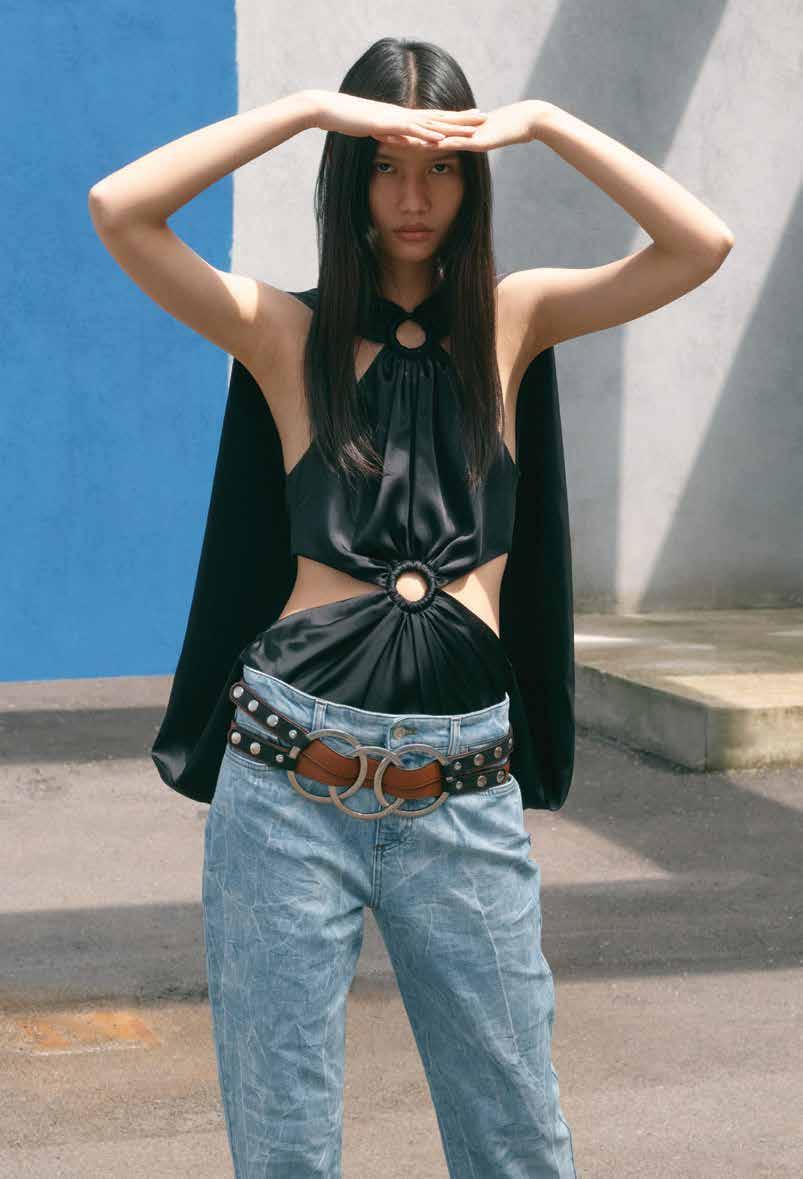
55
‘ My problem is I love everything — minimalism, monochrome, colour, glitter...’
that she’d become frustrated. Like every fashion brand, the pandemic was tough for her business, but even before that, revenue for the year ending in 2019 was around £32 million ($38 million), making her a relative minnow. Small brands don’t always get the attention they need to grow in a conglomerate.
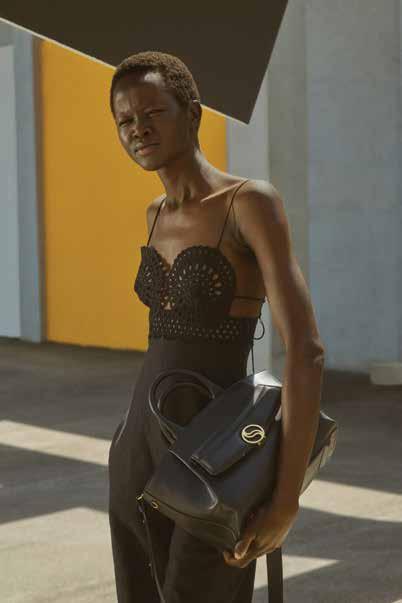
“I loved working with Francois-Henri,” (Pinault, Kering’s chairman and CEO) she says. “But I started to think about all the designers who’d lost their names [after business relationships had turned toxic with business partners] like Jil Sander, and I thought, I’m in a uniquely privileged position of being able to buy back my label, so I should”.


At LVMH she’s not only plugged into the world’s most powerful luxury stable, but has been hired as sustainability advisor to its president, Bernard Arnault. When she was asked, at the time, whether her appointment was a shiny piece of greenwashing, she responded bouncily: “I hope I can be an agent for change from within, like my mother was.” That meant a huge amount of extra credibility for her. “This business is absolutely not some dilettante joke,” she says of her company, becoming so emotional at one point, I think she might cry. “It means so much to me.”

She talks about privilege a lot. Being one of Paul McCartney’s children has probably added an extra layer of well-intended complexity to being the offspring of someone famous. Paul and Linda went to enormous lengths
to lead a normal life. Yet they weren’t. There was the time, back in the 1980s, when Michael Jackson came for dinner at their farmhouse in East Sussex. Of course she couldn’t tell anyone about it at her normal state school the next day. That duality’s always been there. She’s very mate-y with everyone, but her actual friends are Kate Moss, Liv Tyler and Tom Ford, and that can lead people to assume she’s faking the charm with everyday folks.
You probably can’t win when you’re a McCartney and, given what happens to many famous parent’s progeny, Paul and Linda did just fine with theirs. Mary, 53, their eldest, is a successful photographer (and sometime cookery writer, like her mother). James, 45, is a musician. Linda’s daughter with Joseph Melville See, Heather, 60, whom Paul later adopted, is a potter.
Stella, meanwhile, is an undeniably successful, ground-breaking designer, whose husband is also a designer (he was creative director at Hunter for a decade) — also good-looking, also successful.
The couple married on the Isle of Bute in 2003. Madonna and Pierce Brosnan were in attendance. Tom Ford gave them an avenue of trees for their Worcestershire retreat as a wedding present. They’ve since planted a million trees on that estate. “I was riding my horse there the other morning and living my best life and thinking, all that matters is that I get to do all the things I wish my mum had.”

56
‘ I hope I can be an agent for change from within, like my mother was’
AIR
Credit: © Lisa Armstrong /Telegraph Media Group Limited 2023
All pages: Stella McCartney, Spring 2023

57

Motoring APRIL 2023 : ISSUE 139 AIR 58
Hit The Gas
Are electric cars really the future of motoring, or could hydrogen fuel be the answer? BMW is among those considering this natural gas
 WORDS: CHRIS ANDERSON
WORDS: CHRIS ANDERSON


59
It’s not difficult to get your hands on an electric car these days. The major manufacturers all offer them, with plans to make their entire fleets electric in the near future. Reducing our reliance on fossil fuels is key, with BMW among those eyeing hydrogen fuel as another alternative, in addition to electric, something it was recently promoting in the Middle East.
This region is the perfect setting. Realising that oil and gas may no longer be able to support their economies within the next decade or so, as our reliance on fossil fuels decreases, countries such as the UAE are looking to green energy instead, with hydrogen generation one of the possibilities. In 2021, France’s Engie and the Abu Dhabi-based Masdar announced a $5 billion investment for the UAE’s hydrogen industry, while Dubai launched the region’s first major hydrogen plant. The hope is that the UAE will achieve a 25 per cent share of the global low-carbon hydrogen market by 2030, which makes it understandable why BMW was keen to show its iX5 Hydrogen here. There are advantages over electric when it comes to hydrogen. Electric cars are relatively simple by comparison, taking mains electricity, storing it in a battery as chemical energy, then converting it back into electricity to drive the wheels. With hydrogen cars, this natural gas is pumped into the car’s tank and stored at very high pressure, as being far less energy dense that petrol, it needs to be compressed to carry the appropriate amounts — in the case of the iX5 Hydrogen, it stores the gas in two carbonfibre reinforced plastic tanks at 700 bar.
The hydrogen is released into a fuel cell, where the molecules become protons and electrons — the protons then become water, which is the only emission produced, used here by BMW to warm the car’s interior, while the electrons power the car, running it on electricity, but having acquired it in a different way. Hydrogen cars can be filled in minutes, just like a regular petrol car, while electric cars take much longer.
With plans to ship around 100 of the iX5 Hydrogen SUVs globally, BMW hopes to stir interest in the potential for hydrogen cars by sending five to the Middle East. “Hydrogen is a versatile energy source that has a key role to play in the energy transition process, and therefore in climate protection,” says


BMW CEO Oliver Zipse. “After all, it’s one of the most efficient ways of storing and transporting renewable energies, and we should use this potential to accelerate the transformation of the mobility sector. Hydrogen is the missing piece in the jigsaw when it comes to emission-free mobility. One technology on its own will not be enough to enable climate-neutral mobility worldwide.”
To look at, the iX5 Hydrogen is similar to a petrol X5. It was first unveiled as a concept in 2019, with an efficient nextgeneration fuel-cell system, generating a high continuous output of 125kW/170hp, as its centrepiece. In combination with a highly-integrated drive unit, using fifth-generation BMW eDrive technology, the powertrain channels a maximum output of 295kW/401hp onto the road. A 0-100km/h time of less than six seconds is promised, with a top speed of 185km/h, plus a range of 504km.
60 AIR
‘ BMW’s commitment to hydrogen aligns with our ambition to become the world’s most sustainable premium car manufacturer’
It has some neat styling touches too, such as the BMW kidney grille, the inserts in the 22-inch aerodynamic wheels, and the attachments in the outer portion of the rear apron all in BMW i Blue. Mesh inserts cover the cooling air openings at the front, and in keeping with its environmental credentials, BMW says that it has become the first vehicle manufacturer worldwide to use Pirelli tyres made exclusively from certified natural rubber and the wood-based material rayon. Rapid refuelling seems to be the biggest selling point for BMW, but this has drawbacks in terms of where you can actually fill it up. Just 750 hydrogen refuelling stations were in operation globally last year, according to current figures. The technology compared to
that of electric cars is deemed more expensive to produce as well, but any of these disadvantages might be addressed in the case of mass adoption — something the UAE sees a future in, and which BMW is keen to support.



As Dr Hamid Haqparwar, managing director at BMW Group Middle East, concludes, “BMW’s commitment to hydrogen aligns with our ambition to become the world’s most sustainable premium car manufacturer, and provider of individual mobility solutions. Our pilot fleet will complement the region’s energy initiatives ahead of COP28 [to be staged this year in Dubai, Nov 30-Dec 12] and is scheduled for hot-weather testing in the Middle East — an important prerequisite for the vehicle development process.”

61
Food For Thought
Manu Buffara, Latin America’s finest female chef, on why she is cooking to change the world
WORDS: JOHN THATCHER

62 AIR Gastronomy APRIL 2023: ISSUE 139

63
By their very nature, pop-up restaurants are designed to swiftly disappear again. It’s certainly rare that they would still be in location months after opening, let alone a year. But then, when you’ve popped up on a sun-kissed Maldives island that’s swathed in jungle and ringed by slithers of cotton-soft sand and lucent, warm waters, in which pods of dolphin frolic, why wouldn’t you want to hang around?
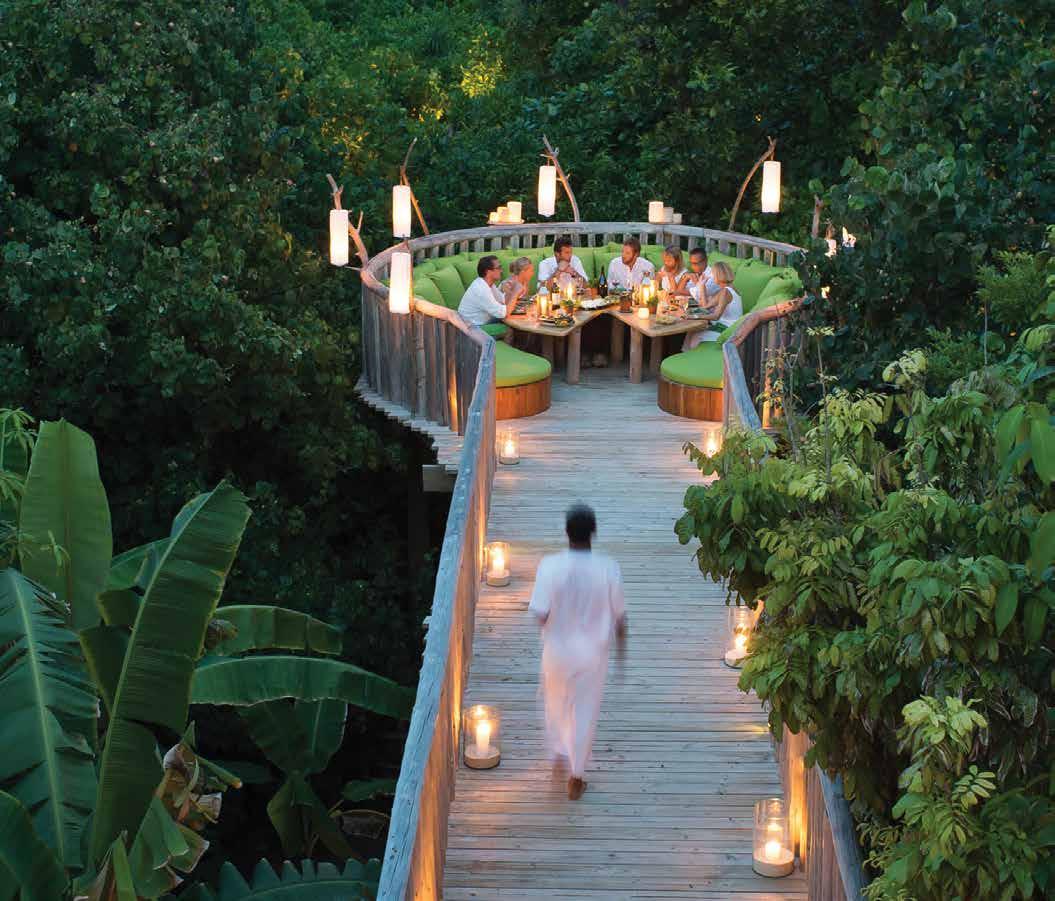
But there’s another reason why Manoella 'Manu’ Buffara, Latin America’s Best Female Chef — as awarded by World’s 50 Best — opted for a year-long residency at Soneva Fushi, which runs until November: “Cooking at Soneva Fushi, for me, is an act of freedom and connection. I believe in the connection between land, sea, minerals, roots, fruits, and animals, and I respect the time, energy and people involved in this process.”
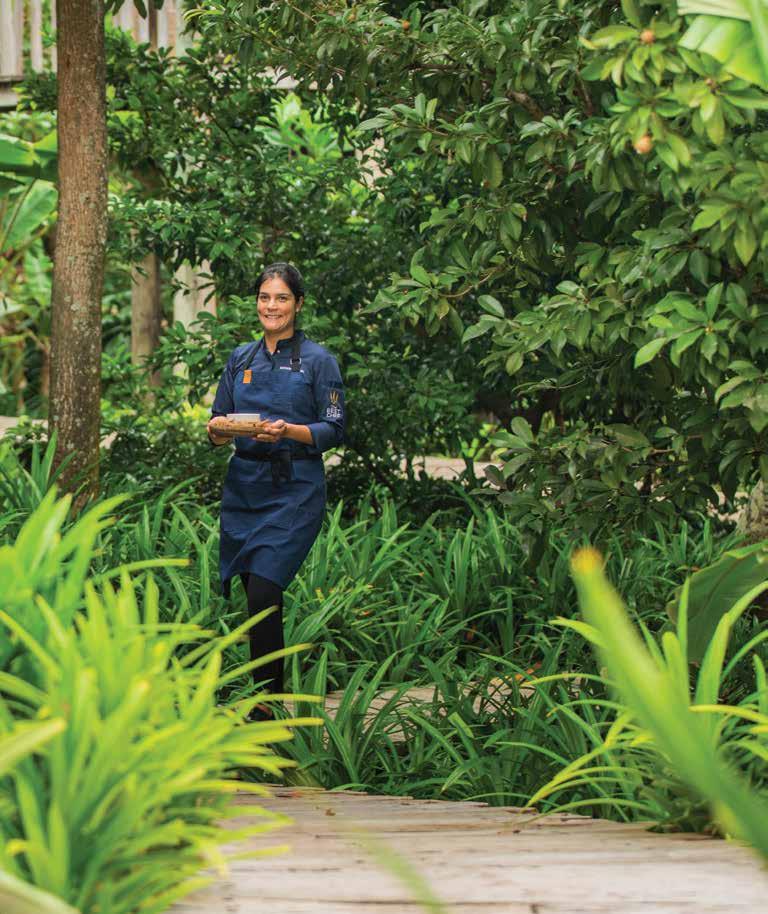
Manu hopes that more and more people come to respect this process, for the good of themselves and the planet we all inhabit. “I think sitting down to share a meal is a sacred moment. I try to create dishes that have a story and hope that those who eat them get intrigued by the ingredients and want to learn more about the process that created the dish. For a meal to be possible a lot of people had to work.
“We, chefs, need to think bigger and spread the same message: we need to take care of the garbage, we need to teach our children to eat well, we need to know more about where our food comes from and who makes it. This needs to be appreciated. We have to understand that a product took a long time to grow, and that there is human work involved. Knowing this helps us to think about not wasting. Gastronomy must be thought of as circular, and we have to close its ends.”
Soneva Fushi is the perfect location for Manu to spread her message. So much thought has been given to lightening its environmental footprint that it was able to issue an A-Z list of all things sustainable on the island, from the architecture through to a stringent zero-waste policy.
“When I first visited Soneva Fushi I was totally hooked by its eco-centre and the sustainable system they have in place there. The leftover food from all the island’s restaurants is processed to become organic compost; styrofoam
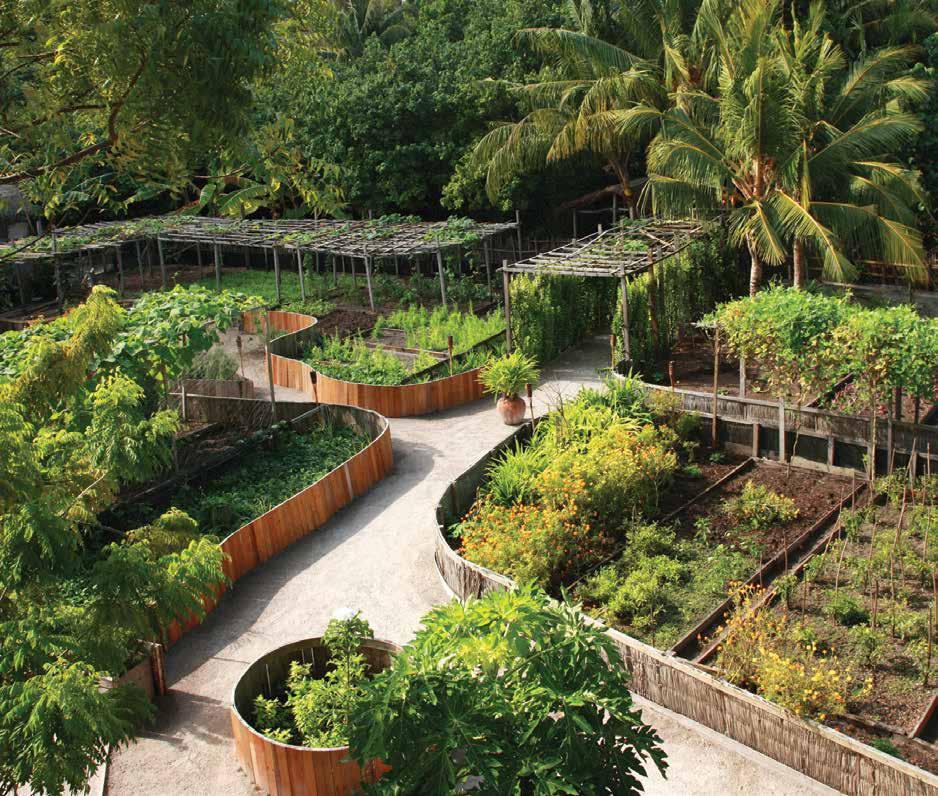
is broken down into pillow stuffing and beanbag fillers. I saw in that space everything I believe every one of us should be doing in our daily routines, and I shared that feeling with the team.”
Manu and her team staff the kitchen at treetop dining destination Fresh In The Garden, its name derived from its location above the resort’s extensive organic island gardens, from which they pluck ingredients, and below cloudless sky. Manu’s menu here serves 35 guests per sitting, and places an emphasis on plant-based, vegetarian and sustainably-caught seafood dishes. “Visiting organic gardens is one of my favourite activities,” enthuses Manu. “But Soneva Fushi’s organic garden exceeded my expectations. It contains hundreds of types of vegetables and herbs, some of which I saw for the first time.”
Gardens play a significant role in Manu’s life. In her home city of Curitiba, Brazil, where her five-table eponymous restaurant continues to rack up industry awards, she performed a pivotal role in the government-backed Urban Gardens project, which allows for vacant land to be transformed into community gardens for the purpose of growing food. More than 5,000 families have since benefited.
“The idea was to develop ways to avoid waste and create simpler and cheaper solutions with the full use of vegetables from the community gardens. I joined a group of chefs and we started visiting the community gardens, giving workshops
AIR 64
to teach cooking techniques. I showed that they can clean their wooden cooking boards by rubbing squeezed lemon pomace on them, or that by mixing organic banana peel and brown sugar, they could make highly nutritional molasses. I was in love with becoming part of this little change in the poorest outskirts of the city. By the end, I was teaching the community farmers how to clean some seeds and learning from them about the preparations they made at home. They would receive me into their homes any time and give freshly harvested vegetables to my girls to taste.” Manu has two girls, aged seven and six. The desire to unite the pleasure of eating with sustainable food production is a seed harvested from Manu’s formative years, growing up in a city but close to her family’s farm. “I remember being raised surrounded by animals. I had a peacock, chicken, rabbit, turtle, fish, and a few horses that my brother and I would take care of. I was responsible for feeding the animals, and since I was very young I learned how to choose a good vegetable.
“Every Saturday I would wake up around 5am to visit our family farm in the countryside. I felt lucky when we arrived on time to see the milk being taken from the cows. I can still remember how good it was to receive a glass of it, still warm and creamy. That made me recognise good milk and how it tastes.
“I also cooked for the first time at my family’s farm when I was around six or seven – I had a small but real kitchen with handmade pans in the backyard. My grandparents would bring the Brazilian pine nut, which is two to three inches long, much longer than the one found in the USA and Europe, and I would cook it over a wood fire to serve to my brother and family.”
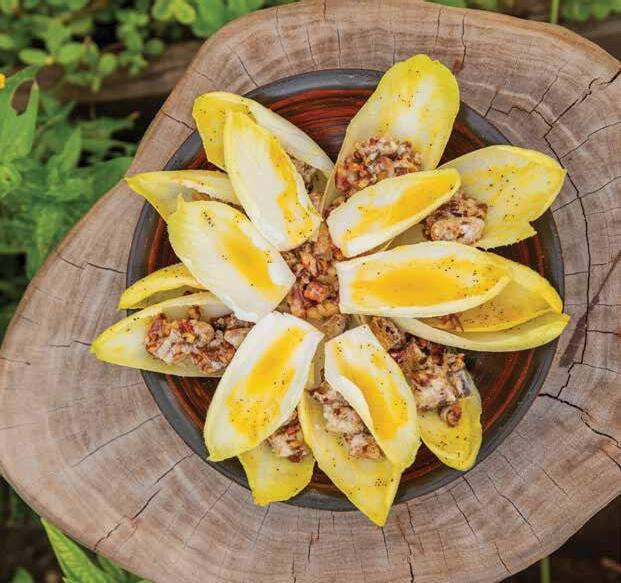


While Manu’s culinary skills have developed since then to now speak of a chef at the peak of her powers, it is her voice that she hopes carries more
weight. She used it during the pandemic, speaking up for the poorest in her community and setting up the Manu Buffara Institute to collect quality food and distribute it to those in need. “I also used it as an opportunity to go beyond simply feeding people to give them good information about what they were eating.
“I will always do my best to make a difference and show that a chef’s voice is even more important outside our kitchens.”

Does she think other chefs in the global limelight are doing enough to turn that light onto the transformative potential of food? “Considering what mankind has done through bad practices in the last few centuries, we will always be late, and it will never be enough. Having said that, I like to look on the bright side of life, it helps me to move forward.
“In Brazil, for example, there is a lot do. But we have accomplished very important changes. In the south of the country there are native bees that produce different kinds of honey. Their hives are much smaller and less productive than the popular bees seen around the world. The honey they produce is more liquid and acidic and ferments faster than the honey everyone knows.

“A law passed last century did not allow producers to sell this kind of honey, as it was considered unsafe. But now we know it is safe and extraordinary. So myself, Alex Atala [the man behind acclaimed restaurant D.O.M. in São Paulo] and other Brazilian chefs started a movement to cook with these fantastic honeys and talk extensively about that now obsolete law. It took us a decade, but now this honey can be produced and sold in Brazil. It changed the lives of thousands of people.
“I have some hives of them in my backyard and in my restaurant’s front wall. I believe, as the bees do, I can change the world doing the best I can. But, just as the bees have a job to do every day so do I. The best way I can do. And I will learn to be a better person in this process. I am not the type of person who likes to complain. I try to find a good way out of every difficult moment, and I have had some very bad moments. But I do not let them take me down.


“I am focused on becoming a better person for me, for the environment, and I think that in this way, I will evolve as well.”
Very much food for thought for us all.
65
‘ I will always do my best to make a difference and show that a chef’s voice is even more important outside our kitchens ’
Lightening The Load
Travel often bears the brunt of anger when it comes to carbon emissions. These resorts are doing something about it…
As travellers have grown more eco-conscious, so too have hotels and resorts taken note. While for the big hotel groups this means a commitment to phasing out single-use plastic products (at best), a few and ever-increasing number of individual resorts have developed a 360° approach to sustainability, pioneering a way of operating that’s more holistic in nature.

At Zuri Zanzibar, environmental consideration has been applied to everything from the décor (made from
recycled materials) and use of lowenergy lighting, to an alternative in-room cooling system, which reduces energy consumption by up to 75%. The resort has also developed an innovative onsite water programme using ozone technology and a desalination system, enabling it to operate without relying on the water resources of its local village, for whom it helps build and maintain wells and educates on the subject of water management, environmental protection, and conservation.
Also deeply committed to supporting
its local community is the Green Globecertified Rockhouse Hotel in Negril, Jamaica. In 2004 its owner established the Rockhouse Foundation, since investing over $7 million in building, renovating, and expanding the town’s six public schools, while members of the community produce all the hotel’s woodwork, candles, and bath amenities in workshops held onsite. Additionally, the water here is heated exclusively by solar power; the bungalows constructed from local timber and cut stone; and the falling rainwater
66
AIR
Zuri Zanzibar
harvested and used to irrigate the hotel’s organic farm and plant nursery.
On Cambodia’s southern coast lies the beautiful Song Saa Private Island, dotted across two small rainforest isles in the middle of a 100-hectare marine reserve, which Song Saa helped to establish. In this little slice of paradise, each villa was built from recycled timber, sourced from discarded ships at a nearby estuary, while furniture is fashioned from driftwood, claimed from local beaches. The entire flooring is comprised of salvaged timber from defunct factories across Thailand and Cambodia. A similar approach was taken to the villas’ interiors. Decorative and ornamental pieces are made by local artisans, primarily from washed-up bamboo root, while old oil drums have been turned into chandeliers.
Song Saa also has a purpose-built system that processes sewage waste and recycles non-sewage water, ensuring that absolutely nothing enters the sea. All food waste is also run through a composting system, before being used in the island’s organic gardens as fertiliser. Meanwhile, the welfare of communities local to Song Saa is maintained by the Song Saa Foundation.
Nowhere treads quite as lightly as Six Senses Svart. Perched on poles above a crystalline fjord at the foot of a mighty glacier in Norway, the 94-room hotel is the first building to be designed and built in accordance with the highest energy efficiency standards in the northern hemisphere. When it opens next year, it will harvest enough solar energy to power the hotel building and its operations – rendering it independent from the power grid.

“The vision for Svart is so much bigger than the project itself; we are trying to use it as a showcase of what can be achieved in terms of sustainability and energy solutions. It’s demonstrating to the guest what we can do, and the extent of what can be done, to really get people thinking about it. I’ve been a vocal critic of the hospitality industry and hotels in general because not enough has been done in these areas,” outlines Ivaylo Lefterov, the hotel’s Development Director.
One hotel group that cannot be accused of being idle is Soneva, a true pioneer of responsible luxury and a fine example of how guiding principles can be applied to multiple properties. Its trio of high luxury, low impact resorts (two in the Maldives, one in Thailand) all adhere to
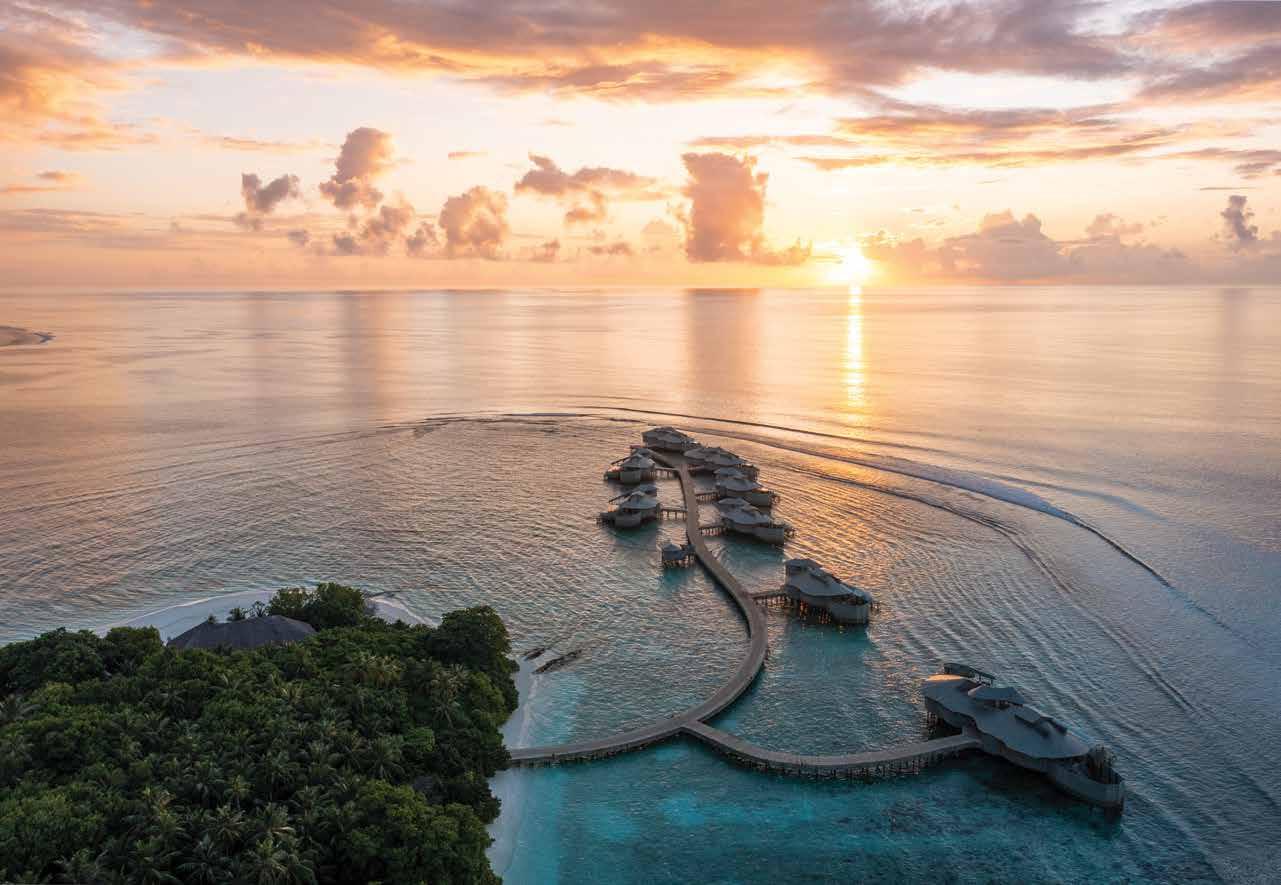
strict environmental guidelines – from the materials used to the food that’s served – and each has an on-site facility to manage and recycle waste. Furthermore, the Soneva Foundation was launched over a decade ago to have a positive social, economic, and environmental impact across a broad range of concerns. One such concern relates to maintaining the natural beauty of the Maldives, at threat from plastic litter that ends up in the ocean, smothering coral reefs and endangering marine life. In response, Soneva Namoona was
an ambitious programme devised to reimagine waste management across the island archipelago, a process that involved Soneva engaging its island neighbours and senior government officials.
The model it engineered has been adopted across the whole of Baa Atoll (containing 13 inhabited islands), while single-use plastics have since been banned country-wide.
Further proof that where there’s a will, there’s always a way to do things better.

67 Travel APRIL 2023: ISSUE 139
‘ One hotel group that cannot be accused of being idle is Soneva’
Six Senses Svart
Soneva Fushi
Dominic Nowell-Barnes
FOUNDER & CEO, THE GIVING MOVEMENT
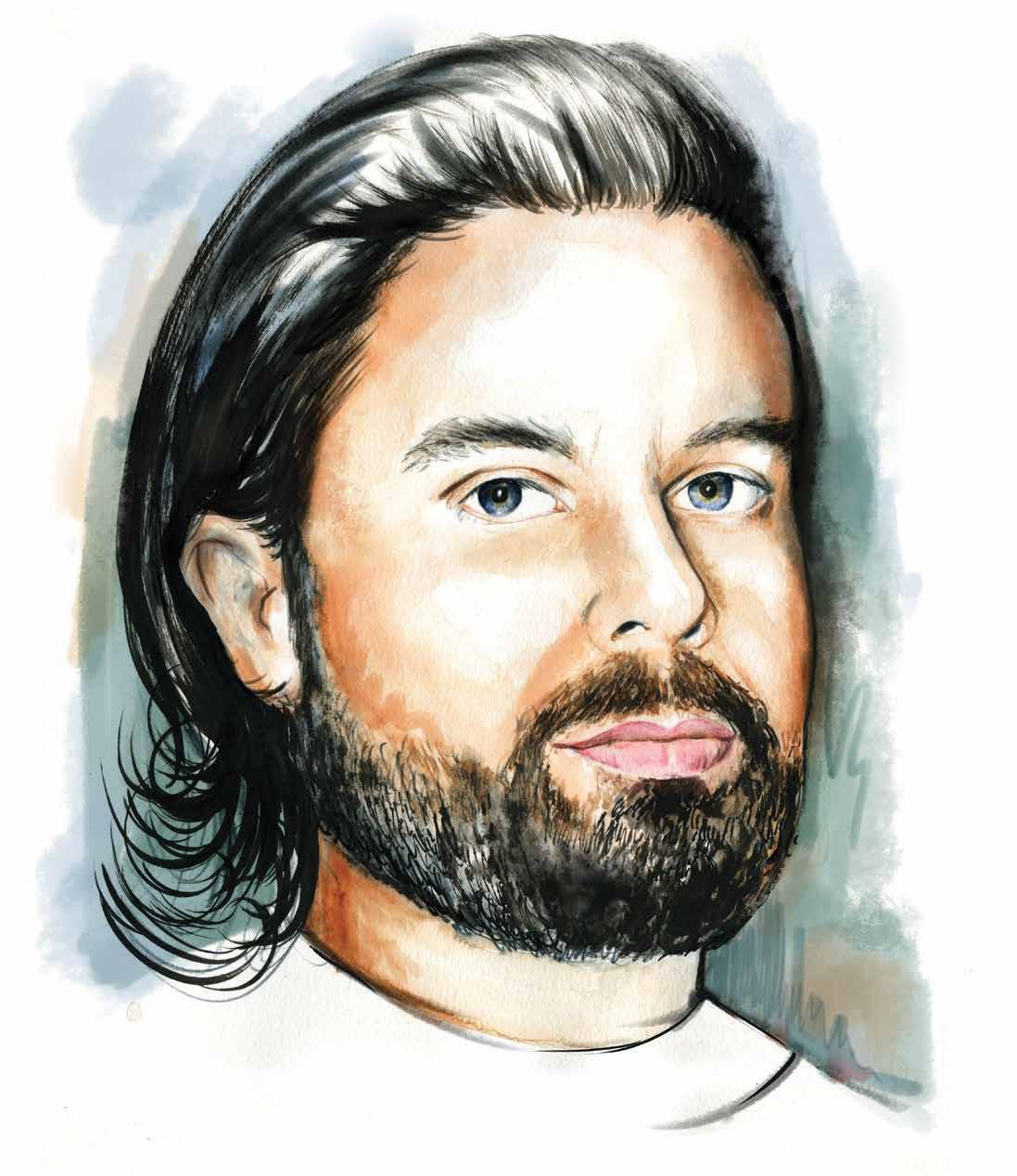
The best piece of advice I’ve ever received is, “If there is no enemy within, the enemy outside can do you no harm”. This was a real eye-opener for me in my earlier years, as it made me understand that if you have a strong mindset, you are accountable to your own standards. No external challenge or opinion you face in life has the power to impact you, only if you let it.
One thing I do every day is a mindset routine. For the last seven years, I have become an avid personal developer, and in the process I read a lot about what is considered the best morning routine to set you up for any challenge you may face for the day. The ones that work for me, and form part of my routine, are focused around a gratitude journal, a daily review of my vision board, and written goals over 1-5 and 10-20 years. I also like to reflect on the traits and values I want to uphold, and how I am currently tracking against them daily.
A lesson I learned the hard way was trying to become an expert in every area of the work that I do, so that I can coach and guide my team at all levels. In my previous company, when the team was smaller, this was easy to do. However, today The Giving Movement’s headcount stands at 150+ team members, and is expected to grow to over 250 by the end of the year. Over the last 12 months, I learnt a lot from Nick Fisher, my COO and mentor, who has taught me, through his experience of managing teams into the thousands, that such a strategy won’t work as you scale. We now hire experts that have far more knowledge and experience than I do in their field.
My definition of personal success is to be able to look back and see how many lives I have been able to positively impact.
My parents inspire me. They had me at the age I am today, in my thirties,
and I can only imagine the extra pressure, personally and financially, they felt to raise a child with love and care while still in the prime years of their lives and careers.
If I could advise my younger self I would say to stay balanced and learn to split your time between your different goals. In my earlier years, I put 100% focus into my first business in the UK, working 15-hour days, 7 days a week, but after a number of years, it failed. The months after that were incredibly challenging for me, as it felt like I had lost my identity, and my only goal. I have since found that work should be balanced with mindset, health, relationships, and giving back — and that even when one of these pillars falls down, the rest will keep you up.
Since moving to Dubai, I get a deep level of self-fulfillment and happiness out of being able to help other people. I want to spend the rest of my life doing this.
What I Know Now 68 APRIL 2023 : ISSUE 139 AIR
Illustration: Leona Beth

LUXURY RESIDENTIAL REAL ESTATE prime.bhomes.com

A Racing Machine On The Wrist RM 65-01 Skeletonised automatic winding calibre 60-hour power reserve (±10%) Baseplate and bridges in grade 5 titanium Split-seconds chronograph Function selector and rapid winding mechanism Variable-geometry rotor Case in Carbon TPT®



















































































































































































